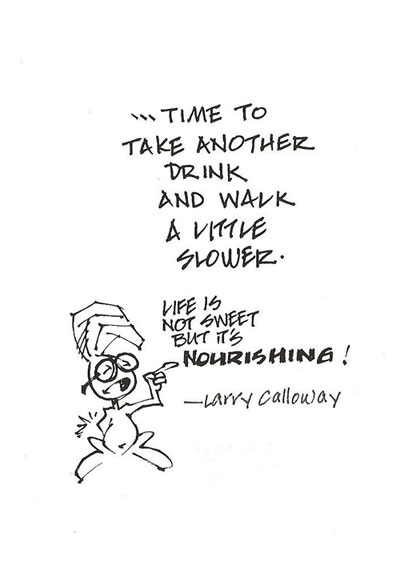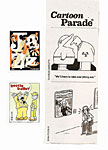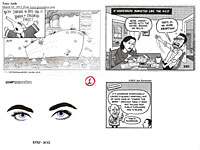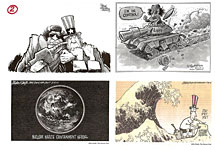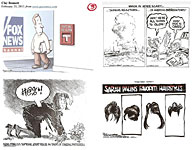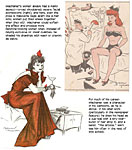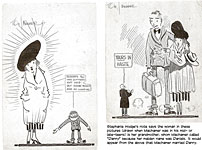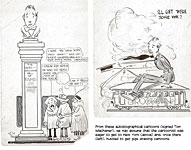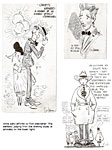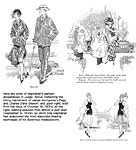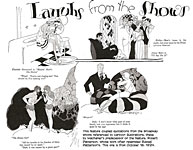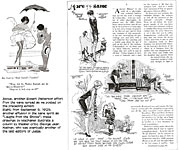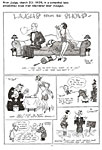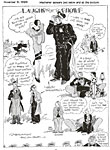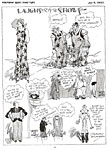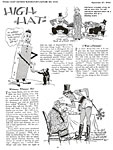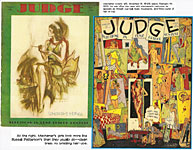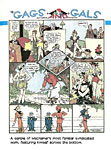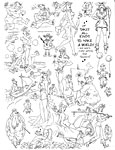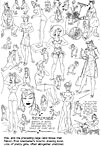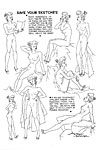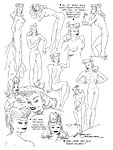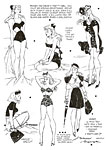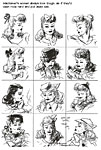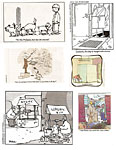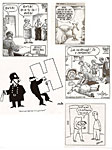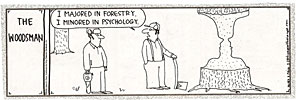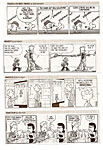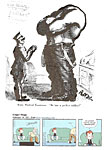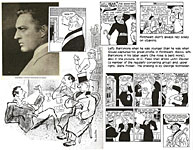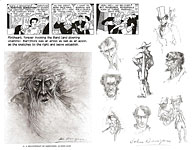 |
|||||||||||||||||||||||||||||||||
Opus 275 (April 4, 2001). This time, a extravagant farrago of the historic, both ancient and current, cartoonist profiles, scandals and alarms, scholarly ineptitude exposes, plus a lesson in appreciating the arts of cartooning and other random acts of violence—as we do our best to prolong the Year of the Rabbit.
In this issue’s biggest stories, we extol the vintage work of Jefferson Machamer, report on South Park’s astonishingly irreverent “The Book of Mormon,” picture Wonder Woman in and out of her new pants, expose Hajdu’s pose as a comics historian, visit the new Dick Tracy and compare Gould’s Vitamin Flintheart with its inspiration (“The Great Profile”), briefly review new The Comics: The Complete Edition, Edie Ernest: USO Singer, Allied Spy, The Cardboard Valise, Happiness Is a Warm Blanket, Charlie Brown; Will Eisner: Portrait of a Sequential Artist (DVD), Secret Origins of the Super DC Heroes (a 1976 effusion), and look at somewhat greater length at funnybooks Lady Mechanika, Human Target, and Random Acts of Violence. Here’s what’s here, in order, by department—:
NOUS R US Stay Tooned No. 6 Is Out Comics Journal Online Revamped Blechman Gets Caniff Award Reasons for Human Torch Demise Ahnold Superhero STAN GOLDBERG’S SHABBY TREATMENT Ken Is Fifty Porn in the Far East King’s Speech Censored (Irony Abounds) Advisory on Border Baggage Searches Universal Uclick Swallows United Media Cartoon Count: Playboy, Parade, The New Yorker Spider-Man on Broadway South Park’s Book of Mormon Wonder Woman Loses Her Pants
DAVID HAJDU’S FAKERY
THE FROTH ESTATE Tina Brown’s Newsweek Charlie Sheen’s Satire
EDITOONERY Some of Last Month’s Shots at—: Budget Crunching, Lybia, and Japan
RANCID RAVES GALLERY Jefferson Machamer Extolled and Profusedly Illustrated
NEWSPAPER COMICS PAGE VIGIL Visual-Verbal Blending Happens Only in the Comics And That’s Why Visual-Verbal Blending Defines the Art
Visiting Dick Tracy and Vitamin Flintheart The New and the Old And Books on Tracy and Gould
BOOK MARQUEE The Comics: The Complete Edition Edie Ernest: USO Singer, Allied Spy The Cardboard Valise Happiness Is a Warm Blanket, Charlie Brown Will Eisner: Portrait of a Sequential Artist Secret Origins of the Super DC Heroes (a 1976 effusion)
FUNNYBOOK FAN FARE Lady Mechanika Human Target Random Acts of Violence
Our Motto: It takes all kinds. Live and let live. Wear glasses if you need ’em.
And our customary reminder: don’t forget to activate the “Bathroom Button” by clicking on the “print friendly version” so you can print off a copy of just this installment for reading later, at your leisure while enthroned. Without further adieu, then, here we go—
NOUS R US Some of All the News That Gives Us Fits The sixth issue of John Read’s cartoonist profile magazine, Stay Tooned, is out and available in single copy ($12) by subscription ($44 for 4 issues) through staytoonedmgazine.com. This is the “Mike Issue,” featuring interviews with editoonist Michael Ramirez (a welcomed long exchange with a conservative master drawer who is seldom as visible as this) and comic books’ Mike Mignola, plus gag cartooner Mike Lynch, The New Yorker’s Michael Maslin, Michael Jantze, Mike Cope, Mike Arnold, and Mike Edholm—plus a couple of laugh-laden stories about Mike Peters by Yrs Trly. John Read, by the way, is the insane person who convinced 140 syndicated cartoonists (of which there is no more notorious a breed of procrastinators) to send him original art for their Sunday releases for a particular Sunday, which Read then assembled into a traveling exhibit, “One Fine Sunday in the Funny Pages”; next stop, Boston, then Chicago, Savannah, Austin and Pittsburgh. The online Comics Journal gave up blogs by various contributors (incl Yrs Trly) in favor of longer, more thoughtful pieces, which began running March 8; meanwhile, this year’s (or is it last year’s) print Journal, No. 301, is still a-borning. ... The movie sequel to “Diary of a Wimpy Kid,” namely “The Diary of a Wimpy Kid: Rodrick Rules,” was the box-office champ March 25-27, beating “Sucker Punch” on its opening weekend, but the reviews of this “Wimpy” haven’t been as wonderful as for the first film: it lacks, they say, the “mischievous luster” of its predecessor. ... R.O. Blechman, illustrator, animator, children’s book author, graphic novelist, editorial cartooner, and New Yorker stalwart, will receive the Milton Caniff Lifetime Achievement Award at the National Cartoonists Society’s forthcoming Reuben Award Weekend in Boston over Memorial Day weekend. Like many perusers of the four-color fantasies (including all of us here at Rancid Raves), Andrew “Captain Comics” Smith doesn’t think Johnny Storm, the erstwhile Human Torch, will stay dead for long. In fact, as he says in No. 1677 of the Comics Buyer’s Guide (May’s issue), “I doubt there’s a fan out there who really buys a death in comics any more” so frequently are the dead resurrected. He offers four reasons for Storm’s demise in No. 587 of The Fantastic Four (which title itself disappears with No. 588). First, of course, “to shake things up.” Or, to be a bit more precise, “to stimulate newsstand sales.” Which worked: No. 587 was January’s top-selling funnybook. Second, Storm died because he “needed a vacation.” Turns out the Human Torch is the only member of the FF who hasn’t had time off in the title’s five-decade run. Each of the others—the Thing, Reed Richards and his wife Sue—has “been absent for lengthy sabbaticals.” Third, the Human Torch had to die because there are too many Human Torches loose in the Marvelverse. The original Human Torch and his sidekick Toro are lurking around in the background, never having properly died. Finally, saith Smith, Storm was killed off because he was a “full-blown moron,” his career “punctuated by bad decisions, puerile behavior, adolescent temper tantrums, and just plain stupid moves.” The FF would be better off without him. For a while. Until he’s resurrected.
***** ARNOLD SCHWARZENEGGER, lately of the governor’s mansion in California, is on the cover of the April 8 issue of Entertainment Weekly because he has finally decided what he’s going to be doing next. No more politics, it seems. Instead, Benjamin Svetkey writes, “The man who was recently in charge of the world’s eighth-largest economy will be turning himself into a cartoon character. And not just any cartoon character, but the Governator, a sunglasses-wearing superhero with an Austrian accent who’ll be at the center of an ambitious, kid-friendly multimedia comic-book and animated tv series co-developed by no less a hero-maker than Stan Lee.” The piece is accompanied by photos of Ahnold, including a nifty one laughing with Lee, and some art by Stan Lee Comics. The drawing of the Governator (which also appears as a fold-in back-up cover) is, like most superhero art these days, a little too up-tight for my taste but some of the other renderings (like that of the arch villain Felon-e, the “17-year-old evil genius behind Felonbook, a social network for hackers”) seem somewhat more relaxed and therefore better, IMHO. Svetkey got a look at the 46-page “bible” that outlines every aspect of the projected series. There, he saw a reference, he says, “to a whole SPECTRE-like organization” of bad guys called Gangsters Imposters Racketeers Liars & Irredeemable Ex-cons (or G.I.R.L.I.E. Men for short)—“but that may end up being changed. ‘The villains still need to be worked on,’ Lee notes.” The animated Governator won’t arrive until the end of 2012, but the funnybook, published by Archie Comics, will show up sooner: “a prototype will likely be ready to distribute at the Sandy Eggo Comic-Con this summer. The same issue of EW offers a guest column by Rainn Wilson, “actor (‘Office’) and author,” who, based upon his experience in the forthcoming movie ‘Super,’ has decided that “superheroes are weird”: “Superheroes are a truly strange storytelling phenomenon, specific to the culture of 20th-century America. Hotties in tight, bright uniforms flying around in masks fighting supervillains, finding kid sidekicks, preserving secret identities, and fostering furtive romances with mortals.” He goes on in this vein for the entire page of his column, pretending he doesn’t understand the conventions of the genre. “What’s with the neon red and kelly green skintight spandex outfits? Do you really think you’re intimidating someone by dressing like a Romanian acrobat from Cirque du Soleil? And what does the cape do exactly?” For Wilson and Schwarzenegger and for the special tribute to Elizabeth Taylor, this issue is worth picking up and stowing away in whatever catacomb you maintain for fond relics.
***** WHEN ARIANNA HUFFINGTON sold her online newspaper Huffington Post to AOL for $315 million, there were a few (albeit very few) moments when those who had been contributing gratis to her parasitic website thought maybe she might trickle down a token or two of monetary gratitude to the toilers whose labors had made her and a few of her inner circle rich. The spurt of revenue seemed suddenly to undercut severely HuffPost’s rationale for using articles and art without paying for them, protesting that there was “no budget” for such payments. Is there now? Not likely, it seems. HuffPost’s senior PR veep Mario Ruiz claims the windfall wealth is being distributed, in some fashion or another, among some 200 contributors. But I know at least one of them, who says he’s yet to see any of this alleged largess. Most editorial cartoonists avoided the snare that HuffPost and other aggregating websites presented when they first emerged: operating on the Internet economic model that since content is free no one can afford to pay for content, HuffPost and others of the same ilk asked for content to be “donated,” contending that the “exposure” a cartoonist received thereby would lead to more remunerative engagements. Pulitzer-winner Mark Fiore was one such, and he said (when interviewed by ComicRiffs’ Michael Cavna): “Huffington Post approached me years ago when they were first starting out, but when they explained that they did not pay contributors, I failed to see the point of joining their merry band of anti-Capitalists. Apparently I’m missing something because it seems to have worked out quite well for them. I’m all for the HuffPost/AOL deal if it translates to healthier distribution of quality journalism online. I hope more dollars and more eyeballs means more journalists can pay the rent.” New Yorker cartoonist Drew Dernavich told Cavna: “I don’t see how any working artist can be excited about the success of the HuffPost deal. It relates to the whole ‘information is free’ mantra movement, which I thought was idiotic.” Daryl Cagle of Cagle Cartoons said: “Fascinating that content has such a high value on the Web—but not for the columnists, whom the Huffington Post doesn’t pay.” In short, it seems no working cartoonist is likely to join the contribute-without-getting-paid band of HuffPost-like websites. Good thing, too.
STAN GOLDBERG SHABBILY SHUT OUT AT ARCHIE Archie Comics, which has lately astonished the comics world with spectacular publicity stunts (Archie marrying, a gay student at Riverdale) and innovative plans (new superhero comic books with Stan Lee), seems bent on perpetuating its reputation as a callous abuser of talent that has been a touchstone of its operation since one of the company’s founders, John Goldwater, claimed to have invented Archie, a grab at fame equaled only by its disregard of Dan DeCarlo, who established the Archie house style of drawing. After DeCarlo, Stan Goldberg’s pencil has done the most to preserve the way Archie and Jughead and Betty and Veronica look. Most recently, Goldberg penciled the watershed marriage series in which Archie marries, first, Veronica, then Betty, an ingenuous contrivance by Michael Uslan that has virtually revived Archie Comics and is now being perpetuated in Archie’s marital magazine, Life with Archie: The Married Life. Providing the stamp of artworld approval, Abrams ComicArts reprinted the marriage epic in slipcased hardcover last year, Archie Marries. Since the mid-1960s, Goldberg has drawn the pictures in virtually every Archie title, including 250 consecutive issues of the flagship title, Archie Comics. As a signal of Goldberg’s place in the Archie firmament, IDW just published The Best of Stan Goldberg, a 15-story compilation of three decades’ work, including specialty art, pin-ups and penciled pages. While all these laurels were heaping up, the suits at Archie were quietly nudging Goldberg out of the house—without actually telling him what they were doing. Goldberg told Frank Pauer, editor of the National Cartoonists Society’s bi-monthly magazine, The Cartoonist!, who interviewed Goldberg in the recent January-February issue, that he suddenly stopped getting assignments last year. No one notified him officially that he was being “retired” after 41 years with the company, but he began to get the message when, after doing five or six covers a month, he was all at once doing none. And when he inquired about work, he was grudgingly given a couple stories a week to do; then just one story a week; then one a month. “It’s the name of the game,” Goldberg ruefully told Pauer. “It’s the business [the same kind of insensitive and grasping treatment] that existed with Siegel and Shuster; it existed with Dan DeCarlo.” And now it’s knocked on Stan Goldberg’s door. Shabby. Golderberg, however, continues to find work at other publishing houses. He’s working with Bongo Comics, and back at Marvel, where he worked as color designer in the watershed 1960s, he did a cover for The Fantastic Four. You can’t keep a good man down. For more about Archie’s high-handed treatment of talent, see Harv’s Hindsight for summer 2001, wherein John Goldwater’s version of how he created the teenage character and the rest of the Archie ensemble is retailed, plus Opus 249 for a quick run-down of the company’s reaction to Harvey Kurtzman’s parody of Archie, concocted as a lampoon of Hugh Hefner’s Playboy but interpreted at Archie as an attack on their iconic character. Sad.
***** This year's National Headliner Award for editorial cartooning went to Mike Peters; second place, Stuart Carlson, and Adam Zyglis came in third. Mike Thompson won the Scripps Howard Award for Editorial Cartooning with a submission containing traditional editorial cartoons as well as his animation; he takes home $10,000 and a trophy. Ted Rall and Steve Breen were finalists. This may be the first time in a long time that Rall has qualified for any award of this scope although his contrarian cartoons certainly deserve some sort of recognition (and they have won awards in the past, beginning, in 1995, with the Robert F. Kennedy Journalism Award—again in 2000—and in 1996, when Rall was a Pulitzer finalist). Edvard Pettersson at Bloomberg.com reports that actor Warren Beatty has won a lawsuit to stop Tribune Co. from reclaiming the television and movie rights to comic-strip detective Dick Tracy. U.S. District Judge Dean Pregerson in Los Angeles ruled March 27 that when Beatty dressed up as Dick Tracy for a tv special in which he was interviewed as the character, he satisfied a clause in the agreement with Tribune to produce a Dick Tracy movie or tv show by a deadline or lose the rights to the character. In an e-mailed statement, a Tribune spokesman said: “At the present time, we are reviewing the judge’s opinion and evaluating our options.” The publisher of Playboy (not founder and editor-in-chief Hugh Hefner but some unspecified corporate entity) has accepted a buyout offer from a partnership headed by Hef, who, even before the successful buyout, owned 70 percent of Playboy Enterprises stock. Now Hef owns even more of his brainchild (or groinchild). According to the Associated Press, Hefner “is betting that the racy magazine he launched in 1953 can still reap profits in the digital age.” One of the strategies he is pursuing is to turn the magazine into a naked version of the “laddie mags” that have for the last half-dozen years festooned the newsstands. The other way is to exploit the Playboy name as a brand, garnering revenue from licensing a range of products such as lingerie, handbags and sunglasses. Ken, Barbi’s boytoy, is 50 this year; he was born in 1961, two years after Barbi arrived, inspired by a German doll based upon a cartoon character, Lilli, created by Reinhard Beuthien. For visuals of Ken through the years, visit Parade.com/ken. Meanwhile, in Shanghai, where Barbi is supposedly a big star, Mattel closed its flagship store on March 7. The six-story store, with spa, café, design studio, fashion stage and shelves and shelves of Barbies and Barbie products, opened just two years ago to celebrate Barbi’s 50th but never took off as a destination for local girls, whose parents, saith the Associated Press, are more likely to buy extra lessons for their daughters than expensive dolls. “Shanghai is a hub for China’s fashion industry,”AP noted, and “Mattel is not the only foreign retailer with an extravagant investment in this huge but challenging market to change strategy. Electronics retailer Best Buy closed all of its stores in Shanghai to focus on expanding outlets with its locally acquired chain Jiangsu Five Star Appliance Co.” In closing its big pink house on Shanghai’s Huaihai Road shopping belt, Mattel explained that it “plans to use its experience in Shanghai to reach customers across China. ‘I have gone on a tour of China!’ a cartoon Barbie says on the store’s website, explaining the brand is on a Barbie Pink Bus Tour.”
PORN IN THE FAR EAST Starting April 1 (no joke), Tokyo began enforcing an ordinance that enables authorities to ban sales to youngsters of manga and anime that are judged by a government screening panel to have extreme sexual content. The ordinance, which also requires publishers to impose self-restrictions on the sexual depictions in their products, initially drew fierce opposition from some publishers and manga artists before enactment. According to mdn.mainichi.jp/arts/news, “foreign publishers dealing with Japanese manga appeared split over the assessment, with some saying it is a matter of course, but others fearing it could erode the industry's creativity, the driving force of popularity achieved by manga and anime. The ordinance was enacted in December only two weeks after being proposed to the metropolitan assembly by Tokyo Gov. Shintaro Ishihara, who is a novelist.” Pornographic video games allowing players to "have sex" with Japanese anime female characters is apparently “the new craze” among teenage boys in Malaysia, reported the Malaysia Star. The game requires the players to begin by dating the girl and then meet her parents. “After successfully going through all the ‘courtship’ phases, the final stage of the game allows players to see the seductive anime character naked and ‘have sex’ with her.”
***** CENSORSHIP is alive and well, as always. In a “tweaked” version of the Oscar-winning film “The King’s Speech” now being distributed to theaters, reports the Los Angeles Times, a scene with actor Colin Firth’s character swearing has been adjusted to omit the F-word. The film won Best Picture with the F-word, so now it’s no longer Best Picture, right? But the alteration gave the movie a PG-13 rating, making it more likely, the suits reasoned, to earn big bucks at the box office than the Oscar-winning R-rated version, which, they aver, will never again see the light of day (or the dark of a movie theater). The objective of the adjustment is to make the film accessible for the “glut of adolescent spring-breakers” lining up to see movies. Another kind of adjustment is afoot at MGM, which is re-issuing its 1984 “Red Dawn,” a movie about a bunch of American teenagers who attempt to repel an invasion of foreign communists. In the re-make, the filmmakers are digitally removing the invaders because they are Chinese and might, therefore, offend the leadership in Beijing. “Why the fear of upsetting such an odiously anti-democratic government?” asks David Sirota in his syndicated column. “Because movie executives worry that a film involving a negative message about China ‘would harm their ability to do business’ there.” And they’re right about that, Sirota continues. “For all the high-minded theories about American cultural exports aiding democratic ferment and challenging autocracy, the dynamic is starting to work the other way as autocracy gives orders to American culture. [With its massive market leverage], China is now countering our First Amendment ethos with a push for self-censorship.”An blatant advertisement for the sheer power of the marketplace, the episode reveals that “the film industry now regularly shapes its products to appease—rather than challenge—the political agenda of the Chinese despots,” Sirota concludes. In China, even Shakespeare is censored. From the Denver Post wire services comes this: “A Beijing entrepreneur, discussing restaurant choices with his fiancee over their cellphones recently (as of March 22), quoted a line from ‘Hamlet’: ‘The lady doth protest too much, methinks.’ The second time he said the word ‘protest,’ her phone cut off.” Ever since the protests in the Arab world got going, “homegrown efforts to organize protests in Chinese cities began to circulate on the Internet,” and the government clearly hopes to head them off by removing any communications about possible “protests.”
ADVISORY ON BORDER SEARCHES Press Release from CBLDF The Comic Book Legal Defense Fund has received an increasing number of reports from travelers who have been stopped, searched, and/or detained by customs agents because of comic book art. In one recent incident, an individual was detained at the U.S.-Canada border while en route to an anime/manga convention. He was handcuffed and held briefly on charges of child pornography, and his materials seized. Such tactics, focusing on expressive materials that are presumptively protected by the United States Constitution, are even more troubling to the extent border searches are not limited to hard copies of materials in a traveler’s possession. Customs agents also may search for information stored on electronic devices, including cameras, laptop computers, cell phones or other storage devices, or on electronic media, such as flash drives or DVDs. Such searches may be conducted at random, with or without reasonable suspicion, and are becoming increasingly common. According to information revealed pursuant to a Freedom of Information Act request filed by the ACLU, over 6,500 people traveling to and from the United States between October 2008 and June 2010 had their electronic devices searched at the border. Nearly half of those searched were U.S. citizens. These developments also cause special concern because few legal protections exist with respect to such searches. The Comic Book Legal Defense Fund has published an advisory document "Legal Hazards of Crossing International Borders with Comic Book Art." This Advisory generally discusses the phenomenon of border searches of expressive materials, describes the basic legal framework governing such searches, and offers some general suggestions for international travelers planning to transport expressive materials. CBLDF legal counsel Robert Corn-Revere prepared the advisory for the Fund's constituents and members. Said he: "Most people do not know that their constitutional rights are not guaranteed, even from U.S. Customs agents, when they cross international borders. Their books, papers, laptop computers, and even cell phones are subject to routine search and possible seizure by the government, even without any suspicion of criminal activity. This is important to know in an age when many people carry with them a great deal of highly personal information in electronic form." The advisory offers suggestions for avoiding intrusive border searches and protecting the safety of your information; it’s posted at cbldf.org.
ZAPIRO DODGES ANOTHER BULLET The South African Human Rights Commission has dismissed a complaint brought by the Young Communist League and its national secretary about the “Lady Justice” editorial cartoon by Jonathan Shapiro (aka Zapiro) that depicted the current President of South Africa Jacob Zuma unbuckling his pants in order to rape Lady Justice. The commission, reported the DailyCartoonist, found the cartoon was “free, open, robust and even unrestrained criticism of politicians by a journalist.” The complaint described the cartoon as offensive because it depicts Zuma as a rapist. But Zapiro isn’t all the way out of the woods yet: Zuma, angered by the cartoon, has filed suit against Zapiro for “damage his reputation and dignity.” That case is still in the courts. For more about Zapiro and Zuma, see Ops. 241, 263, and 271.
***** FOR ALL PRACTICAL PURPOSES, Andrews McMeel Universal is swallowing United Feature Syndicate (UFS), including the Newspaper Enterprise Association (NEA)—long coupled to UFS under the United Media umbrella—with its Uclick division becoming “the full-service syndication partner” for 150 news features and comics, including Pearls Before Swine, Get Fuzzy, Marmaduke, Frank & Ernest, The Born Loser, Big Nate and Miss Manners. Starting June 1, 2011, the NCS Cartoonist! reports, Universal Uclick “will manage all aspects of syndication for the E.W. Scripps’ subsidiary, including sales, editorial, distribution, billing, collection, reporting and licensing fulfillment/management.” Described as “the world’s largest independently owned print and online syndicate,” a designation determined by the online part, Universal Uclick will combine in one website the comic strips and editorial cartoons presently offered at Comics.com and GoComics.com. In a press release, Rich Boehne, president and CEO of Scripps, explained: "After we sold United Media's licensing operations in 2010 to focus on our core news and journalism enterprises, we set out to construct the best operating model for the remaining syndicate, whose primary customers are newspapers across America. A review of our operations—and the marketplace we serve—made it clear that we should seek greater efficiency by teaming up with one of the other remaining players. In Andrews McMeel we found the scale and skills to carry forward the comic properties we have nurtured for many years." In the confessional spirit that animates so much of the ambiance here at Rancid Raves Intergalactic Wurlitzer, I hasten to admit that I am paid a pittance for permitting scraps of R&R to be recycled as a blog at GoComics.
CARTOON COUNT Continuing in our census of cartoons in Playboy, one of the nation’s leading publishers of magazine cartoons, we find Hef holding more-or-less steady from last October through this April’s issue at 5-7 full page color cartoons per issue, plus 8-10 smaller cartoons in the back pages. The number of cartoons is a factor of each issue’s page count, so the ratio of cartoons to pages is more telling than the total number of cartoons. In last October’s Playboy, the full-page cartoon ratio was 1/35 —that is, 1 full-page cartoon for every 35 pages. The ratio for smaller cartoons was 1/14. The combination (not counting the Olivia pin-up cartoon, strips, or special spreads for individual cartoonist’s work, which, in this issue, featured 8 cartoons by Gahan Wilson) produced a ratio of 1/10 (one cartoon every 10 pages). The December issue, which, seconded by January’s, has always been the biggest issue of the year, ran to 198 pages, besting the year’s average 138 or so by a third. The over-all ratio of cartoons to pages was 1/8. Better than the October issue’s 1/10 ratio: the lower the number of pages, the more frequently you encounter a cartoon, and, perforce, the more visibility cartoons enjoy—the more cartoons the magazine is publishing. In Playboy’s heyday, the late 1960s and early 1970s, the page counts of the December issues topped 300, and cartoons proliferated: the ratios in the 1967 and 1972 issues were 1/6 and 1/9.6 respectively. The January 2011 issue, at 174 pages, produced good crop at 1/11, but scarcely up to the ratios of yesteryear. Ratios in subsequent issues, February through April, are 1/10, 1/11, and 1/11. Page counts fall to an average of about 130, and full-page color cartoons number only 4-5 per issue. I’ve
also been watching the Sunday newspaper supplement, Parade, which used
to publish a “Cartoon Parade” every issue—4-5 cartoons each. That number seldom
exceeds 1/issue lately, and then the cartoon is about the size of a postage
stamp. The March 20 issue had no cartoons at all. But the next
week—surprise!—three cartoons, a parade again, and all sizable! Hope springs.
Only to be fiendishly dashed: on the next Sunday, April 3—April being the
cruellest month—two cartoons, both the minuscule dimension of stamps (as you
can plainly see with the help of our convenient visual aid nearby). The other great venue for magazine cartoons is The New Yorker magazine, and I just started keeping track of it. Not counting the back page cartoon captioning contest, the ratios in recent issues run 1/5 to 1/7 fairly consistently. In the most recent issue, however—March 28—there were only 8 cartoons throughout the magazine, for a ratio of 1/15. The drop in cartoon content may have been dictated by this issue’s major article on the unfolding succession of tragedies in Japan. Mayhap the editors were thinking of the August 1946 issue that ran without cartoons at all: the entire issue was devoted to John Hersey’s sober reportage, “Hiroshima,” about the atomic bombing of Japan in 1945 and its aftermath. The article was subsequently issued as a book, which has remained in print ever since.
COMICS ON BROADWAY SOME MORE Spider-Man and South Park The stunt-laden $65 million "Spider-Man" musical can’t get a break, it seems. March was a particularly bad month. NPR.org reported that on March 12, a technical glitch left the Green Goblin dangling in midair. And this mishap occurred shortly after the producers announced that production, which has been in a preview run for a record 103 performances, would be shut down after the April 17 show; previews will resume on May 12, and the official opening, which has been delayed six times, has been moved from the previously announced March 15 to June 14, two days after the Tony Awards (which means it won’t be in the competition, appeasing the producers of other Broadway shows, who have been upset by all the attention being paid a show that hasn’t even “opened” yet). Meanwhile, the Tony Award-winning director, Jule Taymore, who participated in the writing of the show and designed costumes, will be replaced by a “new creative team” that will be brought in to polish the flawed musical. Taymor, who won accolades for “The Lion King” and has been working on “Spider-Man” for nine years, did not go willingly, but she had boxed herself into an untenable position, Patrick Healy reported in the New York Times, refusing to allow anyone else to tinker with her show. As a face-saving maneuver, the producers announced that Taymore is “not leaving the creative team” but that “previous commitments mean that past March 15, she cannot work the 24/7 necessary to make the changes in the production in order to be ready for our opening.” Taymore’s replacement will be Philip William McKinley, who previously directed the Hugh Jackman musical "The Boy From Oz" in 2003 as well as several Ringling Bros. and Barnum & Bailey circuses. The “script doctor” will be playwright Roberto Aguirre-Sacasa ("It's a Bird ... It's a Plane ... It's Superman"), who has written Spider-Man stories for Marvel Comics. U2's Bono and the Edge have already conjured up two new songs for the show. On Friday, March 4, according to Mark Kennedy at the Associated Press, U.S. Department of Labor's Occupational Safety and Health Administration issued citations for four separate workplace safety violations that occurred late last year, resulting in injuries to the cast, alleging “improperly adjusted or unsecured safety harnesses.” Last month, state officials cited the show for two workplace safety violations. But a spokesman for the show responded by saying that the musical "remains in compliance with all government agencies and continues to adhere to all safety protocols." Despite all the bad news (or, ironically, perhaps because the bad news prompts theater-goers to buy tickets in the hope of witnessing disasters live), “Spider-Man" has been among the highest-grossing shows on Broadway since beginning preview performances on November 28; the first week in March, it took in $1.28 million. The Web-slinger had even better luck in distant Dubai: on March 28, Alain Robert, a French skyscraper-climber nicknamed “Spider-Man,” scaled the world’s tallest building, the 2,717-foot tall Burj Khalifa. Robert has climbed more than 70 skyscrapers in various venues around the world, including New York’s Empire State Building. The 48-year-old daredevil has been arrested and fined many times for scaling buildings without safety equipment, and in Dubai, in order to get permission for the climb, he had to agree to use a rope and harness, but the Associated Press reported that “he didn’t appear to use the rope to pull himself up but instead gripped the glass and narrow metal ridges like a rock climber with his feet and bare hands.” He finished by clambering up the tapered spire atop the building and dangling triumphantly for a few minutes before beginning his descent.
FOR SOME WEEKS LATELY, whenever the Broadway pundits could get off the unraveling of the Spider-Man musical, they have been buzzing about “The Book of Mormon,” another musical, which, like the Spider-Man opus, has its origins, sort of, in cartooning—this time, animated cartooning, not comic book cartooning. Written by University of Colorado graduates Matt Stone and Trey Parker, who, saith John Lahr at The New Yorker, “majored in skepticism and minored in cheekiness” and then created the potty-mouthed tv sensation, “South Park,” BOM (as the show is being abbreviated) was widely supposed to make similarly irreverent fun of Mormonism and its founder, Joseph Smith, who created the sect based upon inscriptions he found etched on ancient golden plates he unearthed in the woods near his home in Palmyra, New York, in 1823. The hieroglyphs on the plates Smith translated, Lahr asserts, “while peering at peep stones in the bottom of his hat,” creating the Book of Mormon, which “lives up to Edmund Wilson’s estimation of it as ‘a farrago of balderdash.’” With this sort of fabulous history, Mormonism seems a likely candidate for the Stone-Parker treatment, and, indeed, “South Park” has taken its share of pokes at Mormonism, so Broadway buffs assumed Stone and Parker would continue in that vein with BOM. Maybe, maybe not. Said Parker, quoted in Entertainment Weekly (March 4): “Sometimes we get labeled as people who love Mormon bashing. But the truth is, we just have this fascination with Mormons. They’re so fun to make fun of, but, at the same time, they’re so nice! And they seem so happy! Who are we to rip on that? And that’s what the show becomes about, in a way.” Later in the interview, Parker said: “Like we’ve said on ‘South Park,’ I really do see Jesus and Luke Skywalker and Santa Claus in the same category. And I believe in all three of them.” Added Stone: “We’re all atheist or agnostic, but we really wanted to write a musical that’s pro-faith.” Oh, sure. Maybe they’ve even done it. David Cote, writing for the Observer in Britain (and hence, less likely to be cowed by respectfully tolerant religious correctness), summarized the action: “Starting off in the Mormon mecca, Salt Lake City, Utah, the story follows a mismatched pair of proselytisers, Elders Price (Andrew Rannells) and Cunningham (Josh Gad). [“Puppets of piety,” Lahr says.] The former is the clean-cut ideal of an LDS doorbell-pusher: white-bread, well-groomed and safely asexual. Cunningham, however, is a fat, dim-witted man-child who confuses Mormon mythology with ‘The Lord of the Rings.’ Despite Price's hope for missionary work in Orlando, Florida, the two are ordered to save souls in war-torn, poverty-stricken Uganda. Their evolving friendship lays the emotional foundation for the show, and gives even the cruellest jokes about racism and homophobic self-loathing a sweet, innocent finish. That human dimension reminds you that the comic genius of ‘South Park’ (heading into its 15th season) relies on children blinded by naivety, but who see through society's lies. “Likewise, by smashing together cultural extremes —prim, uber-Caucasoid Mormons and long-suffering, hope-starved Africans— the creators lampoon western illusions about that complex continent (the anthem ‘I Am Africa’ is sung by distinctly pale cast members), while scoring laughs off the sort of horrors that should never be put on a Broadway stage (‘I have maggots in my scrotum’ is a recurring lament by one villager). We chortle disgustedly at an African man who thinks raping a baby will cure his Aids (a documented crime), but truly grotesque is the notion that a couple of Bible-toting white boys can be of any real help. “Religion, the creators firmly point out, is showbiz, and they systematically dismantle the absurdities of John Smith's 19th-century god revelation through the intoxicating frivolity of musical conventions. Of the dozen or so classics referenced in the pastiche score, or by sight gag and laugh line, you can count ‘The Sound of Music,’ ‘Wicked,’ ‘Jesus Christ Superstar,’ ‘The Music Man’ and (naturally) ‘The Lion King.’ Now ‘The Book of Mormon’—aggressively hilarious, blasphemous and almost indecently entertaining—has grabbed a spot in that canon. For those of us who love a well-made musical with satirical bite, the show is manna from heaven.” Stone predicted the musical will not only offend Mormons: "It will offend everyone." But the Mormon church, the anticipated reaction of which raised trepidations all over the theatrical landscape, seems unruffled, issuing a statement that calls the musical "surprisingly sweet." Quipped the Denver Post’s theater critic, John Moore: “Theater, like faith, works in mysterious ways.” Among the most scabrous moments in the production are these (culled from aforementioned Entertainment Weekly): a song with the lyric “F— you, God,” sung by Ugandans raising their middle fingers; irreverent cameos by Mormon founder Smith, the devil, Darth Vader, and Adolf Hitler dressed in black open derriere chaps; the supposed first use of the C-word in a Broadway musical; in one scene, a copy of the Book of Mormon is stuck in an uncomfortable part of a missionary’s anatomy; and an unprintable sequence involving two-foot-long replicas of the male organ. Despite all of this—or perhaps (we hope) because of it—the show is getting the best reviews of any new musical since “The Producers” in 2001. The New York Times’ usually caustic Ben Brantley wrote that BOM “achieves something like a miracle.” Charles McNulty of the Los Angeles Times said: "For all its irreverence—and there's enough off-color insouciance to offend church ladies of every denomination—'The Book of Mormon' has the old-fashioned musical comedy heart of adults who spent much of their adolescence lip-syncing to original cast albums in their finished basements." At the Hollywood Reporter, David Rooney wrote: "In terms of construction and song placement, 'Mormon' masters a classic formula. ... What makes it irresistible, however, is its panache in making naughty mockery of a whole string of untouchable subjects, without an ounce of spite." At the Washington Post, Peter Marks: "The mighty Eugene O'Neill himself would have to have given it up for this extraordinarily well-crafted musical assault on all things holy. The marvel of 'The Book of Mormon' is that even as it profanes some serious articles of faith, its spirit is anything but mean. The ardently devout and comedically challenged are sure to disagree. Anyone else should excitedly approach the altar of Parker, Stone and [collaborator Robert] Lopez and expect to drink from a cup of some of the sweetest poison ever poured." Said Elysa Gardner in USA Today: "Neither the Mormons nor the Ugandans are mocked for their belief systems; they're parodied for their mutual human fallibility." The New Yorker’s Lahr sees BOM as “a road trip to Uganda—Hope and Crosby all over again, with God standing in for Dorothy Lamour.” In the last analysis, it’s not religion that is ribbed but the ostentatiously religious. “The show is smart enough to test the waters of outrage but not brazen enough to take a genuine plunge. The satire is more about the Mormons’ buttoned-down, bushy-tailed style than about the substance of the religion.” It parodies our “fearsome and feverish credulity” and our refusal to think. But it doesn’t go quite far enough to please Lahr. “For all the show’s refreshing novelty, it cops out almost complete at the finale, giving the entire cast of the credulous a free moral pass. ... BOM sets out to attack religious fundamentalism, only finally to embrace Broadway’s gospel of the bottom line. Nevertheless, inspired by the show’s spirit of inquiry, I have two questions for the authors: Why are there no Buddhist soul singers? And, more to the point, if Jesus is a Jew, why does he have a Mexican name?” Ah, those fun-loving scamps at The New Yorker. Doncha just love ’em?
PASSIN’ THROUGH March saw the deaths of some remarkable personages. On March 9: David Broder, a journalist of surpassing dedication, whose syndicated political commentary was distinguished by its even-handedness in an age of ideological warfare; he was 81. On March 26: Geraldine Ferraro, Walter Mondale’s vice presidential running mate in 1984, the first woman nominated for national office by a major political party; she was 75, a bright and shining light to the end. “She was,” quoth Ellen Goodman, a friend and admirer, “savvy, street-smart, opinionated, just one wisecrack short of a wise guy.” The rejoicing at the nomination of the first candidate for vice president who could preface a discussion about abortion by saying “If I were pregnant” was almost immediately cut short by allegations about her family finances and the business practices of her husband, John Zaccaro—often carrying insinuations about ties to organized crime. In response, Ferraro did something no politician before or since has done: she held a press conference and answered every question asked until there were no more questions. It took a long time, but she stayed there until it was done. On February 28: called, by comedian Bob Hope, “the two and only Jane Russell,” she inaugurated the modern trend of movie actresses more noted for their bosom than for their thespian skills. After a movie career remarkable more for thrust than cleavage, Russell devoted herself to her church and charitable work; she was 89. On March 23: Elizabeth Taylor, called “Liz” (which she hated), two-time Oscar winning actress whose figure and violet eyes enthralled, was probably the last of the-living-like-a-movie-star Hollywood personages: she never appeared in public unless she was gowned and jeweled glamorously. In marrying eight times, twice most flamboyantly to Richard Burton, she was also among the last of a puritanical generation: she was a serial monogamist, she said, and she probably married as often as she did because she chose not to live in sin with the men she fell in love with. The Onion with its usual iconoclastic irreverent truth-telling headlined Taylor’s departure: "Gorgeous 25-Year-Old Dead At 79.” Her funeral began 15 minutes late—as directed by the star herself in her final wishes. Said her publicist of the chronically tardy Taylor: “She even wanted to be late for her own funeral.” Witnessing this procession of expiring divas, Zsa Zsa Gabor, who lately lost a leg to medical amputation, suddenly had the premonition that she would be next and was admitted to a hospital for high blood pressure.
***** From ICv2.com:
In mid-March, Warner Bros released a photo of tv’s “Wonder Woman” star
Adrianne Palicki in full superheroine regalia, turning up a few noses among
fans, who found the skin-tight blue pants too shiny, giving off “a cheap Rubies
Hallowe’en Costume vibe that didn’t necessarily jibe with the announced vision
of the new Amazonian warrior as a successful high-powered business executive by
day.” Ever alert to the needs of comics fans, Warner Bros “tweaked” the
costume, shedding the shiny pants. Instead, Palicki’s leggings will be made of
a softer, non-reflective material, bedecked with gold stars down the sides
(somewhat like stripes). She’ll also lose the four-inch heels on the original
blue boots and wear red boots with gold trim and shorter heels—looking “like
something a superheroine could actually run in without totally voiding the laws
of physics.” Nice point, that—the laws of physics, which have, heretofore, been
fairly well “voided” throughout the superhero universe. In this vicinity, we’ve
posted pictures of the new WW and a reminder of the Lynda Carter one-piece
swimsuit look of the last Wonder Woman tv incarnation.
Fascinating Footnit. Much of the news retailed in the foregoing segment is culled from articles eventually indexed at rpi.edu/~bulloj/comxbib.html, the Comics Research Bibliography, maintained by Michael Rhode and John Bullough, which covers comic books, comic strips, animation, caricature, cartoons, bandes dessinees and related topics. It also provides links to numerous other sites that delve deeply into cartooning topics. Three other sites laden with cartooning news and lore are Mark Evanier’s povonline.com, Alan Gardner’s DailyCartoonist.com, and Tom Spurgeon’s comicsreporter.com. And then there’s Mike Rhode’s ComicsDC blog, comicsdc.blogspot.com and Michael Cavna at voices.washingtonpost.com./comic-riffs . For delving into the history of our beloved medium, you can’t go wrong by visiting Allan Holtz’s strippersguide.blogspot.com, where Allan regularly posts rare findings from his forays into the vast reaches of newspaper microfilm files hither and yon.
QUOTES AND MOTS “I think of laughter as the sound of comprehension.”—Tom Stoppard “Dictators ride to and fro upon tigers which they dare not dismount. And the tigers are getting hungry.”—Winston Churchill
STILL FAKING IT AS A COMICS HISTORIAN David Hajdu’s article in the March/April issue of the Columbia Journalism Review may be about Percy Crosby and his comic strip Skippy or about Jerry Robinson as a historian of comics and biographer of Crosby. It’s difficult to tell which; perhaps, then, both. Hajdu is something of an expert at doing two things at once, sometimes out of both sides of his mouth. Diffidently, he claims not to be very experienced in the history of American comics; and then he refers casually to the ten years he spent researching his book, The Ten-Cent Plague: The Great Comic-Book Scare and How It Changed America. So he is apparently both a novice and an expert, someone who poses as an authority but who expects to be quickly forgiven any missteps. Hajdu’s treatment of Crosby and Robinson is respectful and affectionate, but he often glides by facts, sometimes so blithely that he effectively fabricates history rather than reporting it. In describing Robinson’s work with Bob Kane, creator of Batman, Hajdu says Batman’s young sidekick, Robin, was suggested by Robinson; but Robinson, in the biography written about him by Christopher Couch—to which Hajdu refers—says the character was the idea of Bill Finger, arguably Batman’s co-creator. And Robinson’s role in creating Batman’s arch-villain the Joker was a good deal more involved than just showing Kane a playing card, the joker. Similarly, in rehearsing the history of Skippy, Hajdu neglects to mention that the magazine in which the character first appeared was a venerable weekly humor magazine, the title of which Henry Luce later bought when launching his pictorial news magazine, Life. And Skippy was not a “comic-book” kid; he was, for most of his run, a comic strip kid. With his flair for sensation (entitling a history of American comic books “the ten-cent plague” is scarcely an instance of sober scholarship), I’m surprised that Hajdu misses a pertinent—because current—aspect of Skippy’s history, Rosebud Archives’ forthcoming expose, Skippy vs. the Mob: The Fight for Vesey Street and the American Soul. Authorized by the Percy Crosby Estate and Skippy, Inc., the book is reported to reprint a three-month 1930 sequence in Crosby’s strip in which he, through his juvenile hero, took on organized crime. Unhappily, according to Crosby’s daughter Joan Crosby Tibbetts, the episode proved the beginning of the end for the cartoonist: it fueled the peanut butter moguls’ crusade against Crosby. Crosby was about to be embroiled in what has become a debilitating fight with the Skippy peanut butter combine to be compensated for their unauthorized use of his character’s name. The whole sordid mess is detailed at some length by Tibbetts at skippy.com, wherein she recounts the fight that she has been carrying on for the last 40 years. Unbeknownst to her father in 1930, organized crime apparently had corporate ties, as Tibbetts maintains in an introductory essay for the book, with the people who stole Skippy’s name. Although Tibbetts seems sometimes a trifle paranoid on the subject of the peanut butter cabal, it is undeniable that her father’s creation was appropriated as the spread’s brand name without Crosby’s permission and without paying anything for the use of the name. Hajdu concludes by attempting an answer to the question: What happened to Crosby? He says, “Robinson, struggling in the last pages of his book to come to terms with Crosby’s decline, found an easy answer: ‘genius is an enigma.’” But Robinson gave his book a better ending than that. He scarcely throws up his hands in helplessness. In fact, he gives Crosby a triumphant exit. Confined to a mental institution for the last 16 years of his life because of a diagnosis which, Robinson supposes, would not today have resulted in confinement, Crosby “at times achieved a fulfillment and forged an inner peace in that crucible of bitterness. His salvation was his belief in himself and his art and his God. ... While the years were wasted, anguished, and worse, in some ways they were his most productive and heroic. For sixteen years, Crosby personally triumphed over mental and physical illness, neglect, abuse, ridicule, and loneliness. He would not give in to petty tyrannies, real or imagined. He continued to wage his private war for truth and to satisfy an unquenchable fire of creativity.” Crosby went out as a combative artist not as a riddle wrapped in mystery, and Robinson proclaimed it. Yet if you believe Hajdu (which seems an increasingly risky proposition), Robinson was baffled and gave in to an enigma. Despite his manifest fondness for Crosby and Robinson and the comics medium, Hajdu in this article has not much advanced our knowledge of comics and only slightly enhanced our appreciation. He takes us on a pleasant saunter through the field, meandering from paragraph to paragraph to contemplate aspects of the landscape that have caught his eye along the way (critics Seldes, White, and Abel), but his “second read” (as the piece is subtitled) is what in the yesteryear of responsible journalism was called “fluff,” a trivial divertissement which Hajdu has imbued with irrelevant flights of picaresque prose (Robinson straddling a pair of tracks, drawing for comic books and writing for them). Moreover, Hajdu has spoiled the fun by distorting history and ignoring fresh developments that shed new light on part of his subject. I’m surprised such an August publication as the Columbia Journalism Review gives him space to air his fantasies. But then, Hajdu is a professor at the Columbia Graduate School of Journalism. Getting an article published in CJR for a member of the faculty of the sponsoring institution can’t be too hard.
FARRAGO OF BADINAGE Henny “Take my wife—please!” Youngman would have been 105 on March 16. It probably occurs to you that he isn’t around to blow out the candles, but his one-liners live on, deathless comedy. Here are a few of my favorites: “When I read about the evils of drinking, I gave up reading.” “Stay with me—I want to be alone.” “His parents almost lost him as a kid—but he found his way home.” “You know something? No, I’m sure you don’t.” “The sooner I never see you again, the better it’ll be for both of us when we meet.” “The next time you take a bath, don’t fight the current.” “The worst thing about him is that when he’s not drunk, he’s sober.” “You have the wisdom that comes with age—senility.” “What is that you have on—your face?” “I’ll never forget the first time we met. But I’m trying.” “Is your family happy? Or do you go home at night?” “He’s so short—when it rains, he’s the last one to know.”
THE FROTH ESTATE The Alleged News Institution IN THIS DEPARTMENT, we regularly monitor the follies of the so-called “news media.” We do it partly because the fate of comic strips depends upon the survival of a portion of the print news media, the survival of which, in turn, depends, in one way or another, upon how well they serve their purpose, part of which is to make enough money to pay the bills. But we also enjoy the comedy being enacted by some of the news media as they give up altogether any actual news reporting in favor of pursuing ratings and readership, all the while keeping a straight face as they refer to themselves as champions of the First Amendment’s guarantee of freedom of the press, a guarantee that exists mostly to insure that the government doesn’t control the dissemination of facts about our civic lives. And these days, facts are hard to come by. In pursuit of ratings and readership, the news media often makes the news more exciting than it actually is. Lately, for instance, they did it with the tragedies in Japan, particularly in reporting the extent of the radiation threat created by the damaged nuclear power plant. Denver Post columnist Mike Rosen was provoked into the following diatribe: “Although serious, the fallout from damaged reactors ... will like fall far short of the nuclear ‘catastrophe’ that over-wrought media accounts predict. ... The media ‘meltdown’ was to be expected. They’re geared toward sensationalism and alarmism. The newsboy on the corner screaming ‘Extra! Extra!’ has been replaced with electronic media offering instantaneous communication. The Internet has upped the ante, and even the media establishment is Twittering these days. When there’s breaking news, the media spring into action. It’s their moment. They’re needed. In every newsroom, the adrenaline gushes. “Rivalry and competition within the media for the scoop, the ‘exclusive’ interview and the most dramatic pictures inevitably lead to sensationalism. And then there’s the ego factor. Think Geraldo. The rewards in broadcast ratings and print circulation are less for accurate and circumspect coverage than for the dramatic or hyperbolic. Taken to an absurd extreme, you have the National Enquirer. As for alarmism, the penalties for under-alarming are greater than for over-alarming. If the ballyhooed event doesn’t materialize, the public is relieved and soon forgets the overblown warnings. If a catastrophe does come, the public is outraged that it wasn’t alerted. “Don’t get me wrong. I’m not suggesting that the media be censored. They’re an essential part of a free and open society. And I have no practical remedy for their theatrical excesses or political biases. This is just a good, object lesson in the need for the public to take what they see and hear through an informed and critical filter.” Rosen doesn’t say, however, how one becomes “informed” if one must rely upon the wayward news media for information.
TINA BROWN’S Newsweek magazine is another instance of a news medium gone awry in search of a circulation that will enable it to survive. Brown’s been editor-in-chief for several months, which she spent, doubtless, hatching the formula that now infects the magazine. The launch of the “new” Newsweek was officially heralded with the March 14 issue which included the tell-tale editorial by Tina Brown, her first such effusion since taking over. Here, she proclaimed the magazine’s new purpose—to fill in the gaps that the urgency of breaking news has passed by “coming up with an insight or synthesis that connects the crackling, confusing digital dots.” Judging from that issue and the next two under this new rubric, the dots are going to be connected by a parade of opinionated columnists, the more outrageous the opinion the better. Opinion in Newsweek has taken the place of facts (except for a 3-4 page section that sprinkles random factoids with attractive graphics—two bulleted paragraphs that define “plume” as both “a cloud of radioactive material” and “cause of the newest Los Angeles drug craze”). News reporting is virtually nonexistent. Perhaps the magazine no longer has a staff of reporters. Coverage of the disasters in Japan was confined largely to photographs, not text. In place of news, Brown has put personality: most of the feature stories in recent issues are about people, not events. Celebrity and sensation dominate. The latest issue, a double issue dated March 28 and April 4, features a cover photograph of a giant wave over which shriek the words “Apocalypse Now.” Inside we find one article entitled “How to Save California”; another, “Swallowed by the Sea” and yet another “The Mindless Middle” followed by “How Dumb Are We?” In some of the deployment of layouts and use of eye-catching graphics, Newsweek is aping its long-time rival Time, but Time is still reporting events as news, not just personalities. Still, the only genuine news reporting weekly magazine is The Week, which does what Time did when it was founded: it condenses and reports the news in sections that organize the events of the week into digestible clumps. Let me hasten to add that my complaints here are prompted almost entirely by news media management decisions, not by the conduct and professionalism of working reporters in the field and on the ground. Editorial and marketing managers take their product and re-shape it to make it attractive to potential readers/viewers. Although many work-a-day reporters are young and often relatively inexperienced (and therefore poorly paid and, hence, affordable in a financially strapped industry), for the most part, they do a credible job. In a Newsweek story about the recent troubles at NPR, Robert Siegel, co-host of “All Things Considered,” is quoted: “Our problems don’t have much to do with what we do but with the people who manage what we do.” And he might be speaking for the entire reporter cadre. And some of that lot do very well what they do at considerable risk to limb and life—those covering wars and civic unrest particularly. In an annual update report, World Press Freedom Review said 735 journalists died in conflicts between 2000 and 2009; 95 were killed in 2010. (The British-based International News Safety Institute puts the number at more than 1,000 journalists and staff—camera-men, translators, fixers, drivers—killed over the last ten years. “Many died on international battlefields or on assignment to natural disasters, but most died in their home countries,” the Denver Post reported.) The WPFR report says the vast majority of those killed were targeted for death and others died in accidents while on the job. Breaking down the toll by region, CNN says 238 journalists were killed in Asia, 202 in the Middle East and North Africa, 162 in the Americas, 68 in Europe, 53 in the rest of Africa, and 12 in the Caribbean. "If anything, the number of journalists murdered is increasing. Compared to the first half of the decade, the assassination rate for journalists has risen by more than 40 percent," the report said. Probably the journalists who put themselves in harm’s way for a story do so because they somehow thrive on adrenaline, but that doesn’t make their dedication any the less. In Japan, reporters risked potential radiation exposure to cover the damaged reactors story. In Libya, four New York Times journalists were kidnaped and held for days before being released. Covering the Egyptian revolution, CBS News correspondent Lara Logan was beaten and sexually assaulted (pinched and groped, as I understand it) in Cairo. “It’s important to be on the ground,” said CNN’s Sanjay Gupta, who was reporting from Japan. “I’ve proven that to myself in many situations over the years. I’m not a thump-on-my-chest journalist, but obviously this is a very important thing happening in this country and the world.” And the best way to see how it is happening is to be there. We are grateful that there are still journalists who believe as Gupta does. We hope, however, that their bosses and those who manage and often distort their reporting values them as much as we do.
EVEN NEW ERRANT the new bubbly Newsweek can provide insights worth pondering. No other news agency, for example, saw Charlie Sheen’s recent rampage as satire. Here (in italics) are excerpts from Bret Easton Elllis’ report: In getting himself fired from his hit tv show “Two and a Half Men,” this privileged child of the media’s sprawling entertainment Empire has now become its most gifted ridiculer. Sheen has embraced post-Empire, making his bid to explain to all of us what celebrity now means. ... Nothing yet compares to the transparency that Charlie Sheen has unleashed—contempt about celebrity, his profession, and the old Empire world order. To Empire gatekeepers, Sheen seems dangerous and in need of help because he’s destroying (and confirming) illusions about the nature of celebrity. ... Sheen exemplified and clarified the moment in the culture when not caring what the public thinks about you or your personal life is what matters most—and what makes the public love you even more. ... What this moment is about is Sheen solo. It’s about a well-earned midlife crisis [during which Sheen has realized that] he can’t (or won’t) any longer maintain the pose that he thought was required of him. It’s thrilling to watch someone call out the solemnity of the celebrity interview, and Sheen is loudly calling it out as the sham it is. ... Sheen doesn’t care what you think of him anymore, and he scoffs at the idea of PR. ... This is why Sheen seems saner and funnier than any other celebrity right now. He also makes better jokes about his situation than most worried editorialists or late-night comedians. A lot of it is sheer bad-boy bravado—just cursing to see how people react, which is very post-Empire—but a lot of it is pure transparency. And on that level, Sheen is, um, winning. End of italics. Essays like this are not the stuff of news reporting. But they’re engaging and, ultimately, informative. I just wish Newsweek would stop posing as a news magazine. The previous management had it right when they playfully eliminating the fourth letter in the magazine’s name on the table of contents page. Tina and her crew should take notice.
EDITOONERY Afflicting the Comfortable and Comforting the Afflicted The past few weeks have conjured up plenty of outrageous happenings for fun-loving editorial cartooners to play around in, and we have a sampling of some of the best at hand, each page of four bearing a separate red-circled number to which I’ll refer as we view them. In all instances, I begin with the cartoon at the upper left and go in a clockwise progression.
At Red One, we start off with Tony Auth’s ingenious visual metaphor vividly demonstrating just how logical the Grimacing Old Pachyderm in the House of Representatives is behaving as they cut expenditures. Although the GOP pretends to be concerned about women and children (and all such needy folk), the consequence of concentrating upon so-called discretionary spending is that women and children (and all such needy folk) are the first to be thrown overboard. Nicely apt visual. Matt Bors’ contribution to the debate on spending and cutting is, likewise, beautiful in the purity of its aim: before starting to cut expenditures, the GOP House passed legislation that tinkers with the health care reform law in such a way as to limit abortion by putting the burden of denial on insurance companies. Bors, however, doesn’t deal in visual metaphor as much as some editoonists. Neither does Jen Sorensen in her Slowpoke strip for altie newspapers. I’ve tacked-in next only a single panel from her strip commenting upon the brouhaha over public employee unions in Wisconsin. Illogical. But then Governor Walker’s entire crusade is illogical. First, he proposes legislation that will reduce public employee unions’ bargaining powers, saying the objective is to cut cost by eliminating the kind of waste and inefficiency that union rules foster. But when Democrat senators fled the state so a quorum couldn’t be mustered to enact the law, the GOP discovered that they could pass laws without a quorum if the laws didn’t involve money. So they stripped out of the proposed legislation all the items involving money and passed what was left, the part all but eliminating collective bargaining—thereby revealing that Walker wasn’t, really, after cutting cost after all. What he was really after was smashing public employee unions. He tipped his hand earlier in the excitement, getting a law passed that would give $137 million in tax cuts to corporations in the state. That’s income that Wisconsin could have used to help balance the budget. Steve Breen’s farewell to Elizabeth Taylor finishes off Red One. Other editoonists deployed Liz’s eyes, too: Bob Engelhardt had them slowly closing in three stages. But Breen’s is uncluttered and very evocative. Only a few did a cartoon showing the actress being greeted by Michael Jackson. With Red 2, we enter the international scene, starting with Steve Benson’s comment on the reasons for our supposed reluctance to intervene in Lybia. I disagree with his interpretation. While it is logical to suppose that our dependence upon foreign oil deters any impulse we may have for attacking Khadafy, we don’t actually import much oil from Lybia—if any. Most Lybian oil goes to Europe. Besides, one of the reasons we were slow to act, as Prez O’Bama explained on Monday, March 28, is that he felt our first obligation was to get Americans who might be in Lybia out of the country before Khadafy could turn on them. Then Obama had to muster the support of other nations, which took time; but that’s another issue. Benson, here, deploys a deft image to assert an opinion that seems to be not well founded in fact. But it is a powerful image. Nick Anderson then comes along with a telling image about just how efficient and well-equipped Khadafy’s oft-extolled army might be. Not very, it seems—outdated equipment, insufficient supplies and the like. But effective enough, for a time, to keep the opposition warriors at bay. While I accept Baracko Bama’s careful explanation of why and how we entered the Libyan fray, I’m sure he left a lot unsaid. Anyone as thoughtful about governing as Obama is must know what Denver Post columnist Mike Littwin knows. Here are some excerpts: “If this is a humanitarian mission, we can’t leave until Khadafy is gone,” he begins. And the likelihood that the rebels can alone force Khadafy out is remote. “They’re largely composed of protesters gone to war,” Littwin points out, then quotes from Jon Lee Anderson’s report in this week’s New Yorker: “In the past month, men have rushed into combat as if it were an extension of the street dramas, spurred by bravado and defiance but barely able to handle weapons. For many of them, the fighting consists largely of a performance—dancing and singing and firing into the air—and of racing around in improvised gunwagons. In the early days of Khadafy’s counterattack, youthful fighters were outraged that the enemy was firing real artillery at them. Many hundreds have died.” Littwin continues: “If Khadafy doesn’t leave soon, how do we not arm the rebels? How else do they win? How else do we leave? If we arm them, we must also train them. It’s unlikely Americans would be at the center of the operations, but the effect would be the same—an armed force, of which we know little, that we’re militarily supporting.” We may not have troops on the ground, but we’ll have troops on the ground. Neo-con Billy Kristol has a joke about it: “They told me if I voted for McCain, we’d be going to war in a third Muslim country. I voted for McCain, and [sure enough] we’re going to war in a third Muslim country.” Moving clockwise from Lybia to Japan, we have two by Mike Keefe at the Denver Post. The first deploys a familiar image from classical Japanese art, “The Great Wave” by Hokusai, curling as it mounts—representing, as Keefe uses it, the rising alarm about the safety of nuclear power. The alarm threatens to demolish any U.S. inclination to build more nuclear power plants, and the Japanese origins of the oceanic image identify the source of the alarm. Several other editooners used the same image, but I thought Keefe’s was the best mimicry of Hokusai’s picture (it is a virtual tracing) which thereby makes the message clearest. Keefe took another swipe at nuclear dangers in the next cartoon, a quiet evocation of the dangers of radiation that never die. In Red 3, we have a couple jabs at the so-called news media. Deploying a familiar wall-mounted gadget with a new label, Clay Bennett takes a poke at Fox News, which went characteristically bananas about the nuclear menace—“Pants on Fire” indeed. And Chuck Asay provides two images in succession, effectively evoking memories of Chicken Little and a falling sky. Asay has illustrated a novel about “love, sex, and civil rights” (sez he)—Soda Springs, written by Terry Marshall and published by Friesen Press. The author, sez Asay, is “a left-wing, pinko, bleeding-heart liberal friend of mine. As you know, I’m a religious, right-wing, wacko kind of guy, but Terry and I get along like thieves. The book takes place in an area where we grew up.” Back at Red 3, we turn clockwise next to Milt Priggee’s adroit imagery capturing Sarah Livingston Palin’s frequent invocation of the Grunting Old Pachyderm’s favorite Prez, ol’ Ronnie “Funny Hair” Reagan; it’s as if Sarah wants to be Reagan—which, my guess is, she’d have to be in order to be nominated by the GOP. Finally, from Jim Day, an image powerfully conveying the effect on mourners of the Supreme Court’s decision to let that deranged family calling itself the Westboro Baptist Church continue to practice its religion—thanking God for dead soldiers because Americans are learning to tolerate gays. The speech balloon represents freedom of speech, but its pointer is a dagger thrust into the hearts of mourners. Terrible and therefore effective imagery.
***** Rob Tornoe at Editor & Publisher reports that editors at the Las Vegas Sun enlisted the help of staff cartoonist Mike
Smith to craft a unique front page on a Saturday issue of the newspaper,
March 5, employing the style of a “graphic novel” to present a biography of Las
Vegas' famous NASCAR-racing Busch brothers, Kurt and Kyle, kicking off race
weekend in Vegas. Said Tornoe: “If you've got a staff cartoonist at Gratifying to know that some newspaper editors realize the value of their most unique content, cartoons.
READ AND RELISH Joan Rivers on men admiring women for their brains: “No man ever put his hand up a girl’s dress looking for a library card.” Rivers, again, this time at the Kennedy Center on the occasion of George Carlin receiving, posthumously, the Mark Twain Award: “They asked me to say a couple of words for George Carlin. But you can’t say anything about George Carlin in two words. You need seven.” “Sometimes my fears about our future flew at me like bats in a cave.”—Lee Woodruff, wife of ABC news anchor Bob Woodruff while he was recovering from brain injuries received on assignment in Iraq
RANCID RAVES GALLERY Usually Pictures Without Too Many Words But This Time—: MY FIRST ENCOUNTER WITH Thomas Jefferson Machamer was in the pages of Gene Byrnes’ 1950 how-to tome, A Complete Guide to Professional Cartooning. But apart from printing a few pictures of the statuesque wimmin for which Machamer was notorious, Byrnes provided no information about Machamer the man or the cartoonist. Byrnes seems to have set the fashion: to this day, not much can be discovered about Machamer the man or the cartoonist. Most of what I’ve learned about him comes from the Profili volume, Jefferson Machamer: Gags and Gals, edited by Alberto Becattini and Antonio Vianovi, published by Glamour Associated in 2001. Herein, we learn that Machamer was born in either 1899 or 1900 (or, in other sources, 1901), probably on July 5, in Holdredge, Nebraska, just south of Kearney near the Kansas border. He was a precocious artist, as are many who wind up as cartooners, and he submitted cartoons to magazines in New York while still a teenager. After graduating from the University of Nebraska, he went to Kansas City, the nearest “big city,” where he got a job as a staff artist at Willliam Rockhill Nelson’s legendary Kansas City Star. He stayed there only a short time, leaving within a couple years for New York. There, he worked briefly at the New York Tribune, soon, in about 1924, becoming a regular contributor (perhaps a “staff member”) at Judge, one of the venerable 19th century humor magazines still plugging away in the third decade of the 20th century. It was at Judge that Machamer made his mark and established himself as a leading limner of luscious ladies, third only to Russell Patterson, whose contributions to Judge came along later (and who should not be confused with Robert Patterson, another of the magazine’s cartooning stalwarts, concurrent with Machamer, whose finished art looks so much like Russell Patterson’s that Robert occupies the “second only to” designation). In addition to supplying many cartoons and covers, he illustrated a feature called “Laughs from the Shows” in which snatches of dialogue from Broadway shows were quoted, to create, in conjunction with Machamer’s drawings, gag cartoons. And he illustrated “High Hat,” a gossipy review of New York nightlife (then, mostly in speakeasies) written by Norman Anthony; the magazine’s editor (also a sometime cartoonist of the realistic rendering sort), who would later claim: “People had fun in speakeasies. Today’s nightclubs are morgues.” Anthony revived the sagging circulation of Judge, attracting so much attention that he was hired away by the other great humor magazine of yesteryear, Life, then owned by celebrated artist Charles Dana Gibson (of Gibson Girl fame). Anthony performed the same circulation enhancing miracle there, but his triumph was short-lived: the stock market crashed within a year, and Anthony was out of work. When Anthony left Judge, Machamer took over writing “High Hat” as well as decorating it with spot drawings and cartoons. At about this time, Machamer started doing a newspaper comic strip, Patty the Playful, which debuted in April 1928, shortly to be re-titled Petty Patty. Saith the Profili volume: “Promoted by Hearst’s King Features Syndicate as ‘dazzling ... captivating ... irresistible,’ Patty starred a pretty affluent Manhattan flapper, who could be regularly seen in night clubs and country houses as well as on private beaches and golf courses. The daily strip occasionally featured brief continuities, documenting Patty’s misadventures (one of which saw her in the hands of a kidnaping gang). More often, the gags rotated around the attempts to conquer the girl by numerous suitors despite Patty’s having a regular boyfriend, a dim-witted, if well-off, fatso named Tubby Van Sillywill.” The Sunday Patty developed a topper called Past Performances. Patty ceased in October 1929—just as the stock market crashed. Machamer went on contributing cartoons to Judge, branching out, too, to other magazines, Collier’s and College Humor. And around 1932, he concocted another newspaper strip, a Sunday feature, Gags and Gals, which appeared first in Hearst’s New York Mirror, soon syndicated by King Features. Lasting until 1937, Gags and Gals was not a comic strip: published in the Sunday funnies, it was a page made up of a coagulation of single panel gag cartoons (Becattini and Vianovi again), “portraying the verbal exchanges between gorgeous, often scantily-dressed girls and usually all-but attractive, no longer young, males, among whom an evident self-caricature of the cartoonist,” sprouting a frizzy burst of hair atop his cue-ball head, also a moustache and, often, a beret, who appeared regularly in a strip across the bottom of the page. After Gags and Gals expired, Machamer tried again in 1937 with a couple short-lived strips, Nifties and Simple Sylvia. By 1940, he was in Hollywood, where he was writing for and sometimes appearing in short films such as “Cute Crime,” “Fun’s Fun,” “Gags and Gals,” and the kolossally alliterative “Koo Koo Korrepondance Skool,” in which, Jim Linderman assures us at dulltooldimbulb.blogspot.com, Machamer played himself. Between 1935 and 1938, lambiek.net says, the cartoonist “starred in a series of 20-minute surreal comedies produced by Al Christie’s studio, Educational Pictures, Inc., the short comedy unit for 20th Century Fox.” Married, eventually, to actress Pauline Moore, Machamer returned to newspaper comics in 1940 with Hollywood Husband. Based, we suppose, upon personal experience, the strip regaled its readers with the machinations and misadventures of a fellow whose wife becomes a movie star. It didn’t last long. Machamer next produced a strip for the Los Angeles Times—The Baffles, about a small town family marooned in Hollywood. He also continued contributing cartoons to magazines and operated a correspondence course in cartooning from his home in Santa Monica. The gist of this experience he distilled into a book, Laugh and Draw with Jefferson Machamer, published in 1946. Of its 110 pages, 46 are devoted to reprinting his single-panel cartoons, most of which display his ability to draw allegedly toothsome wimmin. Most of the instruction section of the volume is devoted to pictures of these self-same femmes (from which we have culled a hugely representative lot for our Gallery, below), but Machamer eventually gets around to other subjects—shading techniques, the correct use of solid blacks, use of props, how to sell magazine cartoons, cartoons in advertising, etc. Given only a page apiece, these topics are clearly not the ones that most consume Machamer’s interest. All of the educational illustrations are accompanied by Machamer’s humorous patter, an example of which infects his response to the question: “Where do you get your ideas?” To which Machamer replies: “Usually I answer that question with: ‘If I went into the gaffalidduss and sundry shiggablumzy of how I get ideas for comics, the mullatimmick of the whole morgazamm would frighten me out of ever trying to get ideas!!’” Machamer produced one more newspaper comic feature, a gag panel called Today’s Laugh. It was the longest-lived of his creations: it ran from 1948 until 1960. It was his last work, and he produced it until he died on August 15, 1960, at his home in Santa Monica. Now, here’s our Machamer Gallery, beginning with some juvenilia, signed Tom Machamer, sent to me several years ago by a surviving relative, Stephanie Hodge (who may be the cartoonist’s granddaughter via his first marriage, although I’m not quite sure about whether there was a first marriage; but I think there was, Pauline Moore being his second wife).
As I said last time we met here, the characteristic Machamer femme looked like a man in drag—broad shoulders and boobs like baseballs rather than basketballs. His approach to linework was sketchy, almost slapdash, which gave his girls an unattractive bristly appearance, which his treatment of their hair—which always seemed somewhat unruly, various strands out-of-place—emphasized. When he resorted to wash or color, as in our opening illo, most of these off-putting visual tics disappeared, but the faces of the typical Machamer woman remained as hard-looking and therefore masculine seeming as always. Even when they pouted, they just stuck their lower lips out, making them look determined, not seductive. Too bad. But Machamer gained considerable repute with his wimmin, so who are we to carp about it?
PERSIFLAGE AND BADINAGE IN A RECENT ISSUE of The New Yorker, Dana Goodyear, collecting talk of the town, attended a birthday party in Los Angeles for German publisher Benedikt Taschen, who was fifty. Goodyear described the publisher: “Taschen, elegant and slim and mostly bald, with a recessive chin and bulging eyes, was wearing a new suit for the occasion: gray, with wide-set magenta stripes. Hostly, he took Matt Groening over to meet Diane Keaton, who was picking at some risotto. ‘We put the Chemosphere on The Simpsons,’ said Groening, the show’s creator. “That’s how we met.’ Another woman at the table said, ‘Actually, Benedikt looks like Homer.’” Pam Anderson was among the glitteratti, and Goodyear reports that she tossed her “yolk-yellow, wavy mane” and kneaded her cleavage. Goodyear’s reportage was focused on Taschen as publisher of books of photographs of undressed women. Nowhere in the article does he mention the monumental 75 Years of DC Comics or any of the other comics-related tomes Taschen has brought into the light. (Doesn’t even mention that Groening is a cartoonist.) No surprise: anyone who homes in on a fifty-year-old man’s recessive chin and bulging eyeballs is describing a dirty old man who spends most of his time ogling barenekkidwimmin, and with that description, the writer signals the slant of his piece. But the editors had already done that with a headline reading: “Sexy Books.”
NEWSPAPER COMICS PAGE VIGIL The Bump and Grind of Daily Stripping THE UNIQUENESS OF THE ART: WORDS BLENDING WITH PICTURES. To celebrate
the return of this department to this niche of the Internet, we’ll take a
longer time than usual to examine specimens of the genre by way of re-stating
one of the critical principles I’ve frequently (tediously) touted. As I’ve been
saying for several tedious eons now, what makes the art of cartooning unique
among the visual arts is that it blends pictures and words to achieve its
narrative purposes. Probably the best way to understand the way in which words
and pictures blend in cartooning is to look at a few single panel gag cartoons.
In a good gag cartoon, the picture doesn’t make sense without the words. The
picture is a puzzle; the words explain in some fashion the puzzle. By the same
token, the words don’t make sense without the picture—or, more precisely, the
words don’t make the same sense that they have in the cartoon without the
picture. Take a look at these. In our first example at the upper left in our visual aid, the words give some sort of meaning to what the dogs are doing in Rob Harrell’s cartoon. Ditto at the right, the caption of Jerry Van Amerongen’s Ballard Street panel. Both the captions make perfect sense without the picture, but not the same sense as the words do with the pictures. Try a couple more on the tier below, going from left to right, then down the page, a tier at a time. The comedy in Gary McCoy’s cartoon arises from the dog’s having misunderstood what the conductor is doing with the stick—er, baton. But neither words nor the picture make the same hilarious sense without the other. In Mike Baldwin’s Cornered cartoon, the words, “sculptor’s block,” give humorous meaning to the picture; and vice versa. And again in another Baldwin cartoon at the lower left—without the pictures, the words “wishy” and “washy” don’t quite make sense. In the next Baldwin at the lower right, the verbal and the visual blend for comedic meaning, but there’s something else going on here, too. I can imagine a movie short that makes the same joke, but it would seem awfully contrived. Here, Baldwin doesn’t have to work so hard: the pictorial fake explains how the innocent consumer fell for the trick of the fake Rolex: if he believed the salesman in the alley was real, it required no great leap of faith to believe in the Rolex. And it’s done with such economy that it makes the joke. Some comedy, like this last cartoon’s, is possible only in the medium. At
the top left of our next exhibit, Dan Piraro’s Bizarro cartoon is
a sterling example of comedy possible only in the comics. Ditto Bill
Whitehead’s Free Range joke. Sometimes, admittedly, the principle can be carried a little too far. At the left, the miscreant in Ariel Molvig’s New Yorker cartoon is making off with an ‘H,’ perhaps having stolen it from the London bobbie’s speech. Yes, it can happen only in a cartoon, but the giant ‘H’ is not something you find littering the landscape every day. Verisimilitude teeters and threatens to tip over when a cartoon relies too much on its cartoonishness to make the joke. London policemen are called bobbies as homage to Sir Robert Peel, who launched the London police force; in Ireland, cops are called “peelers” for somewhat the same reason. Aren’t you glad you dropped in today? Such a font of knowledge bubbling up hereabouts. To the right of the ‘H’ gag is another Bizarro panel. Piraro’s gag here is not an example of our text for today: I’m including it because it’s pretty funny, and as an in-group joke, it derives added entertainment if you know that the speaker is Piraro’s self-caricature. The last specimen by P.S. Mueller could happen only in comics, and it’s not using its cartoonishness for the comedy. “The
Woodsman” in Hilary B. Price’s Rhymes with Orange comic strip may
be an extreme example of verbal-visual blending: we’re looking at an optical
illusion after all. But the visual makes no comedic sense without the
lumberman’s comment, and the comment isn’t funny without the picture. To
leap, unabashed, from the foregoing discussion of how words blending with
pictures in single-panel cartoons make the arts of cartooning unique, let’s
look at some stories that can be told only in the comics—comic strips, that is.
Some “stories” are jokes, and because comedy makes a visual-verbal blend so
obvious, the secret of its functioning is easier to see in comedy than, say, in
tragedy Some jokes make no sense without the verbal-visual blend that is at
the heart of cartooning. Here are a couple examples. The first strip on this page, Stephan Pastis’ Pearls Before Swine, seems, at first blush, a little simple-minded: it deploys its cartoonishness for the gag. Okay, the lettering is on the wallpaper, and we, the readers/viewers, are easily sucked in to mistaking those letters for the usual way the sound of sleeping is depicted in comics and assume, thereby, that Pig is asleep. But when we get to the last panel, we realize that Rat has been sucked in, too. This joke is possible only in a comic strip. Below that, is a less complicated visual-verbal joke in Jef Mallett’s Frazz. The joke can take place only in a comic strip where Frazz can stretch out to “measure” the space available to him, a comic strip character. And without his comment, no joke. Kevin Fagan toys with his medium in quite another way in Drabble, next down the page. I suppose you could pull this gag in a motion picture, but I’m still tempted to say “only in the comics.” The joke in Jim Davis’ Garfield, however, can work only in a comic strip. The
all-time champion comic strip for continually contriving comedy in ways that
can be achieved only in the comic strip form is Zits, the collaboration
of Jerry Scott, who mostly “writes” it, and Jim Borgman, who
mostly draws it. They say of their collaboration that each of them does 75% of
the work. Seems accurate enough. Here are a few: That the first one is possible only in a comic strip seems obvious. The next two, scrolling down, are perhaps less apparent. But in both, the multiple images not only attract attention to themselves (an important aspect of competing with other strips on the same page for readers) but create, by their very multiplicity, a puzzle that the concluding panels “solve.” Only in the comics. In the bottom two strips, the visual devices to which Scott and Borgman have resorted may seem obvious. But, as Samuel Johnson is said to have remarked about the alleged genius of Gulliver’s Travels, once you have thought of little people, the rest is a foregone conclusion. Well, yes. But thinking of the little people wasn’t all that easy. You can find this sort of deployment of image and verbiage in Zits several times a week. I can’t help thinking that a contributing factor may be that Borgman has more creative time on his hands these days than he did when he was also doing editorial cartoons several times a week. To fill the time, he doodles up more and more outlandish combinations of word and picture. Not that he thinks about it like that. He doubtless doesn’t work by formula—i.e., words and pictures must blend. But combining words and picture into a telling image is how a cartoonist thinks. That’s his way of being. He does it without, er, thinking about it. The verbal-visual blending aspect of my critical criteria for examining and appreciating the cartooning arts is often, alas, misunderstood. Looking for verbal-visual blending in examples of the cartoonist’s craft is only the first step in appreciating the artform. Verbal-visual blending is not the only criterion. Other steps are detailed in one of my books, The Art of the Funnies (which is shamelessly offered for sale near here), and are hinted at in my essay, “Defining Comics Again,” in Harv’s Hindsight for December 2005 (if you’d care to review all that while you’re looking at this screen). Taking the first step enhances your awareness of the interdependent roles of words and pictures in cartooning; you get a little bit into the creative so-called mind of the cartoonist. Once there, you’re in a better position to assess and understand how the medium functions. Herein, I’m merely emphasizing the first step. Here’s
one more Zits—only in the comics. Down the page, we have a Sunday The Knight Life by Keith Knight. The gag here is enhanced by the layout of the panels, which depicts the flight of the football and the triumphant catch at the end. The insert at the end with its joke is almost an afterthought: the real treat here, and the essential cause of our enjoyment, is in the layout and its exquisite timing. Only in the comics. Next, Rhymes with Orange is a cartoonishness joke, but nicely done. Below that, though, we have a superb instance of a joke possible only in the comics—all those contact lenses scattered around the swatted fly. Speech
balloons, an often essential ingredient in the comic strip genre, are coming
into their own as the foundation of gags. The eccentricity of lettering customs in comic strips is the basis of the gag in Brian Crane’s Pickles. Ditto in Mark Tatulli’s Heart of the City. And
here, to close our sermon on this aspect of cartooning with a clash of cymbals,
a crescendo of concluding images. First, from Robert Minor: Below Minor is Ginger Meggs, which is to the Australian newspaper comics page what The Katzenjammer Kids is to the American funnies: an undying institution. And in this strip, like Minor’s cartoon, words and picture blend to give each a comedic meaning neither has alone without the other. The perfect comic strip.
VISITING DICK TRACY As we mentioned previously, Chester Gould’s cleaver-jawed sleuth is now in the hands of a new creative team, writer Mike Curtis and cartoonist Joe Staton. A TMS website/press release supplies some background details about the new dynamic duo (verbatim): Joe Staton has been drawing comic books for many years and has more than 1,000 credits under his belt, including stints at Charlton Comics, where he co-created the cult hero E-Man, and at Marvel Comics, where he inked Avengers and Hulk books. The majority of his work, however has been published by DC Comics, where he co-created The Omega Men and The Huntress, Darknight Daughter. He is perhaps best known for his work with the Green Lantern comic books, for which he created several alien Green Lanterns, including Kilowog, Salakk and Arisia. And Dick Tracy isn't Staton's first trip downtown. During 1998, he penciled Mickey Spillane's Mike Danger strip. Mike Curtis, who has been writing comics since 1986, is the only former law-enforcement officer to work on Tracy. A former deputy sheriff in Orleans Parish, New Orleans, he brings a seasoned copper's eye to the gritty stories the strip will increasingly tell. Curtis also maintains a number of contacts in the law-enforcement community who are providing input as he and Staton begin development of Tracy's next generation of high-tech crimefighting gadgets. Curtis' previous writing credits in comics include Richie Rich and Casper the Friendly Ghost for Harvey Comics. End of press release. Somewhere in the immediate vicinity of this deathless prose you’ll find the new team’s first week on the strip.
On their first Sunday, Curtis and Staton wave a fond farewell to the retiring master of Tracy’s fate, Dick Locher, putting his name on an auditorium. Judging from the evidence at hand, the new Tracy, like Locher’s, features lots of talking heads. This somewhat tedious tendency is doubtless a direct consequence of the shrunken allotment of space newspapers grant to comic strips. But Curtis and Staton, unlike Locher, manage to insinuate details other than facial into their effort. Staton, interviewed at online Hogan’s Alley, described how he and Curtis work: “Mike writes 'em and I draw 'em. We'll talk about what characters we want to feature and what directions we want to go, but Mike figures out how to pace things for the dailies and the Sundays and how it all comes together. One thing that may be a little specific to us is that Mike writes the strips as storyboards. He thinks visually, like lots of good writers, and actually roughs out panels for me to see what we need. The way Mike has things blocked out, the stories will be averaging a bit over a month each. The Trib [Tribune Media Services syndicate] agrees that this accommodates attention spans being shorter these days. You'd be surprised how much content you really can get into three panels. We're hoping to set a whole new standard for pacing strips.” “Hogan” then asked about the degree of violence that might be permitted in the strip. Gould’s strip was often drenched in bloodshed but “Hogan” speculated that newspapers these days are not likely to permit that kind of graphic violence. Said Staton: “When I was doing ‘Scooby Doo,’ the last shot was always the crooked real estate developer being hustled into the cruiser. Dick Tracy's villains don't say, ‘Drat! I would have gotten away with it if it weren't for you pesky cops!’ The Trib tells us that they see Tracy as ‘a tough urban cop.’ They've put no restrictions on how we handle that, other than to ask that especially gruesome deaths take place off-panel. There is a death scene in our second continuity that we think Chester Gould would have appreciated.” The Trib’s restrictions are sometimes laughable. Locher was once advised to keep the verbal content in the strip at 35 words or less because today’s readers don’t like to wade through a lot of verbiage. That made me laugh. Even the most dedicated word-averse citizen can tell with a glance at the newsstand that this artifact, a daily newspaper, is just crammed full of words. Why would the potential reader of the paper even buy a newspaper to begin with let alone read the comics if he/she were so word averse as to eschew reading a comic strip because it has more than 35 words in it? You can, if you haven’t already, read my entire 1994 interview with Locher at Harv’s Hindsight, posted just a couple weeks ago. I’ve been wandering through Gould’s Dick Tracy lately, indulging a nostalgic impulse encouraged by IDW’s sumptuous Complete Dick Tracy reprint series. From the early forties on, Gould concocted extraordinarily grotesque villains, personages whose names described their physical deformities or personality disorders—Littleface, the Mole, B-B Eyes, Pruneface, 88 Keyes (a pianist), Laffy, Flattop, the Brow, Shaky, Measles, Breathless Mahoney, Itchy, Shoulders, Gargles, Influence, and so on. Once he latched onto grotesques, Gould seldom staged a story without one, and some of his later inventions—Wormy, the Pouch (whose face was so voluminous with folded flesh that he could hide things in it)—were grotesque to the point of nauseating. But in the 1940s, Gould was golden. And he was funny. It was in this decade that he created his most endearingly comedic characters—B.O. Plenty, Gravel Gertie, and, even, some of the bad guys. Shaky, who trembled uncontrollably, indulged a peculiar and laughable hobby: he constructed model ships inside bottles. Highly unlikely and therefore very funny. Best of all was Vitamin Flintheart, the once (perhaps) great stage actor, now down on his luck. But never without a speech to spout, ringingly as if from the stage of the Palladium. Flintheart was a caricature of John Barrymore, the celebrated Shakespearean actor of the first decades of the 20th century, sometimes dubbed “The Great Profile” because of his imposing profile.
In his later years—past his prime in all, perhaps, but drinking capacity—Barrymore was renowned as an imbiber of adult beverages without peer. This trait Gould echoes in Flintheart’s constant ingestion of vitamin pills. But it was in Flintheart’s profile and flowery speech that Barrymore was most closely imitated. Gene Fowler, a journalist whose career ran parallel to Barrymore’s, met the actor in 1918 and spent countless hours in his company. In 1943 or thereabouts, after Barrymore had died, Fowler wrote a biography of his friend, and in the opening chapter, he recalled his first meeting with the actor, backstage, in Barrymore’s dressing room at a production of “Redemption.” Barrymore took the young reporter with him to visit an old friend at a rooming house specializing in broken-down actors. Here’s Fowler (in italics): We at last arrived at an old and sepia-colored boardinghouse on West 41st Street. When asked concerning the identity of this cavernous place, Barrymore replied grandly: “We are in a sepulcher of dynastic majesty. The Valley of the Kings.” A rotund lady materialized from the catacombs, embraced and was embraced by Barrymore, who called her “Marie, my Blossom!” Over Marie ‘s shoulder and from a hayloft of gray hair, he testified: “She’s one of my father’s old flames. Bequeathed her to me.” Marie tittered uneasily [and then reported that she had been forced to ask “the Baron,” the personage Barrymore was there to visit—an old retired actor—to leave because he wasn’t paying the rent]. “What!” roared Barrymore, advancing on her, and she retreating as if hobbled in a barrel of lard. “Oust a philosopher? A savant? A seventh son of a seventh son? Where is your sense of values?” Gould has captured exactly the sound and fury of Barrymore in Vitamin Flintheart. Barrymore did more than merely mouth the speeches of plays he’d acted in: he was, in his own right, a font of bon mots. Here (in italics) are some of his: A man is not old until regrets take the place of dreams (he once said). America is the country where you can buy a lifetime supply of aspirin for one dollar and use it up in two weeks. I would like to find a stew that will give me heartburn immediately, instead of at three o clock in the morning. Happiness often sneaks in through a door you didn't know you left open. I am thinking of taking a fifth wife. Why not? Solomon had a thousand wives and he is a synonym for wisdom. Barrymore was sometimes more than a little grandiose: Die? I should say not, dear fellow. No—Barrymore would not allow such a conventional thing to happen to him. But he did die. On May 29, 1942. And Fowler wrote his biography, entitled Good Night, Sweet Prince. Fowler asked a mutual friend to make a drawing of Barrymore that the writer intended to hang on the wall of his study next to another souvenir of his friendship with the actor—and next to a clock that had stopped running for years. Fowler thought that when Barrymore died, he would set the clock’s hands at the hour of his friend’s death. When he heard Barrymore had died and ascertained the hour of his passing, Fowler went to the clock to set the hands. “As I moved to do so,” he wrote later, “I found there was no need.” The hands of the clock had stood for more than two years at ten-twenty, the hour of Barrymore’s death.
WE WILL REACH the 80th anniversary of Dick Tracy’s debut next October, and IDW, in a festive mood, has issued a commemorative tome, The Very Best of Dick Tracy: Bullets, Battles & Bad Guys (144 8.5x11-inch pages, b/w; IDW paperback, $19.99), the content culled from IDW’s ongoing “complete” reprint project. (So if you have all of those, you don’t need this one.) The book is a sort of sampler of Dick Tracy, printing nearly two dozen stories—or parts of stories; most are not complete. Only a few pages of the Flattop adventure, for example, and just the death of Shaky. And the last story in the volume is such a fragment that the villain of the tale doesn’t even appear. (But with a character like this, the Chameleon, perhaps we can’t say for sure.) Only Gould stories are included, starting in 1931 and ending in 1971. Mercifully, Tracy’s sojourn on the moon as a “space sheriff” is only alluded to. Each story is briefly introduced by journalist and comics connoisseur Jay Maeder (whose last comics gig was writing Annie), who, in less than a paragraph, attempts to bring us into the ensuing tale, which, in most instances, is missing the setup (and sometimes, as I said, the ending). Although some of the content samples the better known of Gould’s work (Flattop, the Brow and the Summer sisters, Shaky, Mumbles), the first strips in the book have not been reprinted (except in the IDW volumes). Thumbing through them, we can see how dramatically Gould’s storytelling skills improved over the years. The first story herein, from November-December 1931, follows almost at once Tracy’s joining the police force in order to find the murderer of his fiance’s father. It features a car chase sequence which is so badly presented that we don’t know which cars have bad buys in them and which one is the one with Tracy in it. Throughout this tale, the breakdowns are so clumsy that they destroy continuity and clarity. And Gould’s drawing skill is still rudimentary enough that it cannot rescue his presentation. Two years later, Gould’s drawing has improved, but the story included here doesn’t show much improvement in storytelling: one daily strip ends with Tracy and his perpetual sidekick, Pat Patton, crouched in the bushes outside the mayor’s mansion, and Pat shouting, “Tracy—look!” But even though the next strip in the sequence appears next, we never learn what it is that Pat wanted Tracy to look at. Gould, however, gets better and better, and one of the treats of this book, which telescopes the years thereby emphasizing the evolution, is in watching him improve, quickly—page by page almost. A story from 1938 is revealing in another way. Once Gould hit his stride in the late 1930s and early 1940s, his stories tended to be built more upon the personalities of the crooks than the crimes they committed. The crimes were taken from the news of the day, but they served mostly to give Gould entree to introduce another picturesque bad guy. But this 1938 tale is markedly different. As Maeder says: “Extraordinarily brutish and nasty even by the strip’s lurid thirties standards, the ‘Chains of Crime’ story found Tracy and the Coast Guard chasing the odious human-cargo smuggler Stud Bronzen on the high seas,” where Bronzen is bringing Chinese into the country illegally—and whipping them frequently to keep them in line. In these early adventures, Tracy is seen much more frequently than in later years tackling the criminals with his fists, expressing thereby his abhorrence of crime and criminals in purely physical terms. In the human-cargo story, he’s so pissed-off and obsessed that he has the handcuffs taken off one of Bronzen’s arrested henchmen so he can beat the guy up. “How does that feel, smuggler” he says as he hits the guy in the face and gives him a bloody nose. The Very Best of Dick Tracy is a handy and inexpensive way to be introduced to the world’s second best known detective (Sherlock Holmes probably outshines Tracy). The book’s only drawback is that its format results in the strips being reproduced a good deal smaller than they appear in IDW’s Complete volumes. Too bad, but not terrible. One more Tracy tidbit. In 2007, Gould’s only child, a daughter, Jean Gould O’Connell, published with McFarland Publications a biography of her father, Chester Gould: A Daughter’s Biography of the Creator of Dick Tracy (232 7x10-inch pages, b/w; hardcover, $45). It is a satisfyingly insightful book, marred, but only slightly, but the daughter’s oft-expressed adoration for her father, whom she relentlessly worshiped, and mother. “How blessed I was to have had such wonderful parents,” she writes. “I always marveled at how Dad could be whatever the occasion called for.” The volume is illustrated with 173 photographs, incidental drawings, and reprints of various Tracy strips. For some unaccountable reason, the line drawings are all half-toned, so instead of being black-and-white, they’re dark-gray-and-light-gray; and that blurs the pictures somewhat. Daughter Gould writes about her father’s ambitions and disappointments, and family events, and she discusses her father’s work as a farmer as well as his work as a cartoonist; he managed the farm at their place near Woodstock, Illinois. The narrative often includes Gould’s own commentary, taken from recorded conversations he had with his daughter. He rehearses the evolution of his career from painting advertisements on barn roofs at age 17 to documenting violent crime in Chicago to inventing Dick Tracy. The daughter also delves into her father’s correspondence files over the years, finding, after his death, the agreement he and the Tribune-News Syndicate had signed upon his retirement. He was given a choice—lifetime retirement income or the copyright of the strip. “Knowing that the Dick Tracy copyright would not ensure financial security, Dad chose the lifetime option,” she writes. And then, reading the agreement carefully, she realizes that her father did not retire voluntarily: the syndicate had asked him to leave. The book may be ordered at mcfarlandpub.com or 800-253-2187.
QUOTES & MOTS From the opening pages of a book entitled Common Nonsense: Glenn Beck and the Triumph of Ignorance, here are a few bon mots arranged by James Baldwin and quoted from his Notes of a Native Son: Sentimentality, the ostentatious parading of excessive and spurious emotion, is the mark of dishonesty, the inability to feel; the wet eyes of the sentimentalist betray his aversion to experience, his fear of life, his arid heart; and it is always, therefore, the signal of secret and violent inhumanity, the mask of cruelty.
CIVILIZATION’S LAST OUTPOST One of a kind beats everything. —Dennis Miller adv. At an auction in December, Lee Harvey Oswald’s first coffin went for $87,469. JFK’s assassin got a new coffin when his body was briefly exhumed in 1981, and since then, the original wooden coffin has resided at the funeral home whose operator had swapped the new one for it. From Harper’s Index: Number of times GeeDubya’s memoir refers to his loss of the 2000 election’s popular vote: 0. The 52 members of Congress identified with the Tea Baggers, who vow to cut federal spending, requested a total of 764 earmarks valued at $1 billion over the last fiscal year, reported the NationalJournal.com. From the Washington Post: Since most of the 5,800 Catholic priests accused of sexual abuse in the U.S. were never criminally charged, most have simply disappeared back into the lay world, unsupervised by authorities and not identified on sex offender registers.
WORD OF THE YEAR. The American Dialect Society, continuing a tradition of unknown longevity, determined that the Word of the Year 2010 is “app.” Other groups have other choices. Merriam-Webster picked “austerity.” At the New York Times, they dithered over vuvuzela (a word that doesn’t sound at all like the sound-maker it names), top kill, static kill, bottom kill, and refudiate, among other esoteric candidates. The New Oxford Dictionary landed on refudiate, which it approved of (as do I), saying it was “neither ‘refute’ nor ‘repudiate’ but seems consistently precise, standing more-or-less on its own, suggesting a general sense of ‘reject.’” Meanwhile, the Oxford English Dictionary added 900 new words to its online update, including a host of Internet terms that qualified by crossing over into everyday use: OMG, BFF, IMHO, and TMI (for—Oh, my God; best friends forever; in my humble opinion; and too much information) as well as offline terms—muffin top, wag (meaning “wives and girlfriends”), and “heart” as a verb (taken from the popular use of the heart symbol, as in “I heart New York”). But when Michigan’s Lake Superior State University published its annual Words to Be Banished From the Queen’s English for Mis-use, Over-use and General Uselessness, refudiate was on the list; ditto viral (as in “it went viral”) and wow factor among others. About viral, one person wrote: “This linguistic disease of a term must be quarantined. If one more thing goes viral, I’m buying a hazmat suit and moving into a clean room.” (What’s a hazmat suit? Stands for “hazardous materials” suit, a protective garment. Oh.) By the way (although not at all incidentally), the rationale, if any is needed, for picking a “word of the year” is that the words that come into frequent use through a year indicate the preoccupations of the populace; the words become, then, a shorthand snapshot (to scramble a metaphor or two) of the national psyche. Just another thing that we don’t actually need.
BOOK MARQUEE Previews and Proclamations of Coming Attractions
The Comics: The Complete Collection By Brian Walker 659 9x12-inch pages w/color; Abrams, $40 A BRAND NEW EDITION of this book is now out. It is, Walker told me, “essentially the same as the Borders exclusive except for a few upgrades. The two separate indexes were revised and consolidated into a single index in the back. To fill up the space I gave them images of the Abrams limited edition lithograph series that was done in 1978 (six images on four pages). And I added my current favorite Cul de Sac to the sampling of contemporary strips at the end.” The six images are of characters from Hal Foster’s Prince Valiant, E.C. Segar’s Popeye, Dick Moores’ Gasoline Alley, Mort Walker’s Beetle Bailey, Walt Kelly’s Pogo (a Selby Kelly pencil drawing that does not reproduce well here, too bad), and Roy Crane’s Buz Sawyer, in which we see Buz’s sidekick, Roscoe Sweeney, stranded on a desert isle, surrounded by (and happily groping) naked full-bosomed native damsels and saying, as he sees a seaplane on the horizon, “Oh, no—other guys are missing in action for years. Why must I be rescued so soon?” Richard Thompson’s Cul de Sac replaces Lola by Steve Dickenson and Todd Clark in a line-up late in the book. Walker managed to excise Lola, Dickenson, and Clark from the index but evidently didn’t have time to include Thompson or the name of his strip. A teeny tiny factoid hardly worth mentioning, which, of course, is why I mention it. Here at Rancid Raves Intergalactic Wurlitzer, we’ve reviewed this book in its various stages: when it first appeared as The Comics After 1945; and again when the prequel came out, The Comics Before 1945; and, finally, when Abrams republished both volumes, combining them into a single vast tome in 2008. I repeated both of the reviews when the combined volume appeared; see Opus 234 and Opus 235. As I said before, then, the book is full of fugitive special drawings made by the cartoonists for assorted unsyndicated purposes, and most of the comic strips illustrating the text are reproduced from original art. A genuine treasure trove. For anyone interested, even vaguely, in newspaper comic strips, their history and evolution, this book is indispensable. And I say that even as Jerry Robinson’s revised The Comics: An Illustrated History of Comic Strip Art 1895-2010 sits in the corner of the RR lair, awaiting review. A preliminary leafing through the pages reveals that the revision is a stunning improvement on the initial 1974 version, which, for its time, was a landmark publication. More about it next time. Or the next.
Edie Ernst: USO Singer, Allied Spy By Brooke McEldowney 96 8.5x11-inch pages, b/w; Pib Press paperback, $19.99 AN ABSOLUTELY ENTHRALLING story of love and sex and the tenterhooks of espionage, it appeared first in newspapers, daily, under the heading 9 Chickweed Lane, McEldowney’s superb comic strip, brimming, always, with mature topics given a light humorous touch and a profound humanity. 9 Chickweed Lane is what a newspaper comic strip could be if they all grew up. The Edie Ernst story ran an unprecedented 11 months from late 2009 to mid-2010. With its length, McEldowney violated most syndicate dicta about such things, and when he got to Edie’s love life, he also violated syndicate prohibitions against alluding to human sexuality. For the book reincarnation, McEldowney dropped some strips because, he says, “they digress from the story in book form.” But “in propitiation, and for the fun of it, I’ve thrown in some new art.” “For the fun of it” probably describes how he approaches doing his daily and Sunday strip: as published, the final product fairly hums with the good time he’s having. Chances are, you’ve never seen 9 Chickweed Lane: because most newspaper editors have impoverished visual imaginations and may still think the comics are the children’s section of their papers (all evidence to the contrary notwithstanding), the strip doesn’t run in many newspapers. And that’s why you should get this book: you aren’t otherwise likely to witness comic strip storytelling as it should be done. Pib Press is McEldowney’s imprint, so you should order directly from him at either pibpress@gmail.com or Pib Press, P.O. Box 942, Kennebunk, Maine 04043. You won’t regret it. Ever. I’m looking forward to re-reading this epic myself, this time in narrative chunks larger than daily installments. (And I just finished: another storytelling masterpiece from McEldowney. You’ll laugh; you’ll weep. You’ll enjoy the nuances of the medium’s capabilities as never before.)
The Cardboard Valise By Ben Katchor 128 8x10-inch landscape pages, $25.95 THIS IS KATCHOR’S FIRST BOOK in ten years, about which Malcolm Jones in Newsweek writes: “Katchor’s picture stories [perhaps a graphic novel?] seek out those insignificant but oddly memorable, often humorous aspects of city life, [which he] then turns inside out, giving us his daydream of a city, eight panels at a time. ... Katchor is plainly steeped in the tropes of his craft, but ultimately, he is uncategorizable, a man apart. Or, as he puts is, ‘You set up your tradition for what a picture story is, and you live up to that.’ ... Katchor may shy away from the word ‘artist,’ but he does what every great artist does: clarifies things you knew but didn’t know you knew, or didn’t know how to articulate. Spend some time with his work, and then take a walk. You can’t go a block without bumping into one of his people.” I’ve never gotten “into” Katchor that far; maybe this time I will. I just ordered the book.
Happiness Is a Warm Blanket, Charlie Brown By “Charles Schulz” in the person of his son Craig and Stephan Pastis 80 7x10-inch pages, color; Kaboom! hardcover, $19.99 ALL THIS TIME, I thought Peanuts would never be produced by anyone other than Schulz. I thought Schulz made it pretty clear: after I’m gone, no one will continue the strip. Well, yes—the strip. But we’ve already had a couple of “new” video incarnations of Schulz’s creation, and on March 29 we had another, a direct to video release of an animated feature with the name above. And the hardcover version described above, drawn by Bob Scott, Vicki Scott and Ron Zorman. The publisher’s news release posted at the end of February was accompanied by four sample pages, and I’m happy to say that the rendering apes Schulz perfectly—the way his drawings appeared before his hand got shaky. But the page layouts and narrative breakdowns are a dramatic departure from the usual funnybook format: instead of the standard grid, we have half-page panels, embedded panels, vignettes of characters in “panels” without borders. Worth a look I’d say, but maybe not for twenty bucks.
Will Eisner: Portrait of a Sequential Artist Produced by Andrew D. Cooke and his brother Jon B. DVD, 96 minutes; $19.95 THIS BIOGRAPHY of one of comics’ most influential practitioners hits the usual high spots—Eisner’s entrance into professional cartooning via a partnership with Jerry Iger, his creation of the Spirit, his army stint during World War II and subsequent involvement in instructional comics (arguably his life’s work), his notorious introduction to underground comix (he was mildly alarmed at the cartoonists’ long hair and funny smelling cigarettes but shocked at the pornographic content of S. Clay Wilson’s work, the first of the breed he saw), his passion for the graphic novel and the literary quality of comics, and his final labors to eradicate anti-Semitism. As is almost always the case with Eisner biographical efforts, he is credited with inventing the graphic novel when he didn’t; herein, he seems to claim credit for inventing just the term graphic novel, but he didn’t do that either. But this video makes up for such errant asides with ingenious manipulation of static images to create the illusion of motion and some astonishingly rare film. In the latter category, footage of his childhood and youth, his father and mother, his army career, and his own family (wedding, wife and children, including poignant passages showing his young daughter playing at the beach), revealing, among other things, that Eisner was a little on the chubby side for much of his post-WWII life. On camera, Eisner discusses how his daughter’s death at age 16 devastated him and probably influenced his first attempt at a graphic novel, Contract With God. Eisner’s reticence here to admit that Contract was almost autobiographical is a little eerie: he says he wasn’t aware of its autobiographical content at the time he was producing it, becoming conscious of that aspect of the work only later on. The video is loaded with on camera interviews with stellar personages in the field—Joe Kubert, Denis Kitchen, Art Spiegelman, Jules Feiffer, Kurt Vonnegut, Frank Miller, and Gerard Jones, all at some length; plus snippets with Gil Kane, Stan Lee, Michael Chabon, Jack Kirby, Michael T. Gilbert, Sergio Aragones, Tina Robbins, Scott McCloud, Neal Gaiman, Neal Adams, Harvey Kurtzman—all judiciously integrated into the narrative whole. (I was interviewed by the Cooke brothers early in their project, but, alas—my poor, suffering ego—I don’t appear on camera, although my name appears, inexplicably, in the list of cooperating people at the end.) While most of the witnesses here attest to Eisner’s talent and acumen, the defendant himself doesn’t say much about the nature of the medium or how he exploited its elements to create innovative comics art. For that, you might want to consult another video, No. 11 in Stan Lee’s series, The Comic Book Greats (Stabur Home Video). (Stan, as always, is corny incarnate, but Will is instructive, and thereby reveals something of his understanding of the nature of the medium that he helped to shape.) Or buy one of Eisner’s instructional volumes, Comics and Sequential Art or Graphic Storytelling and Visual Narrative. One of my favorite Eisner utterances is alluded to in the Cooke enterprise. Eisner usually maintained that he was not so much gifted as he was lucky in his soaring to fame as a comics creator. He was in the right place and the right time, we might say; but he, quoted by Kitchen, put it differently: it was raining and he was there with a bucket.
Secret Origins of the Super DC Heroes Edited by Dennis O’Neil with an impressively brief Introduction by Carmine Infantino 240 8.5x11-inch pages, color; Warner Books paperback, originally $6.95 but now priced as a rare tome PUBLISHED IN 1976, this volume is a good example of how bad our comics history books were back then. I ran across a reference to the book a month or so ago, and, intrigued by the description of its contents, which allegedly reprint the original appearances of an assortment of DC’s superheroes, pairing each with a contemporary example of the same character, I sent for it through AddALL an online book-finder contraption. Here we have two stories each about Superman, Batman, Green Lantern, Green Arrow, Wonder Woman, Atom, Flash, and Hawkman. The initial appearances of Captain Marvel and Plastic Man are also reprinted, but not the contemporary versions (because both, probably, were encumbered by copyright problems even though both were ostensibly owned, then, by DC; or maybe there were no “contemporary versions” at just that 1976 moment). But I wouldn’t swear to it that the so-called “origin” stories are actually the first appearances of the characters (or, even, that they’re supposed to be). I can’t tell for sure because nothing is dated. Each pair of superhero’s stories is introduced with an essay by O’Neil, who regales us with anecdotal tales about how the character was conceived and what happened subsequently, but he is annoyingly cavalier about such historical data as the date of the characters’ first appearance in print (or the date of the character’s “origin story,” if that’s what’s supposed to be here). Sometimes he mentions such things; sometimes, he doesn’t. Throughout, there’s a confusion about whether the book intends to print “origins” or “first appearances”—sometimes the two occur in the same story; other times, not. And the writers and artists of the early stories are not identified. The names of the contemporary creators appear on the stories’ splash pages, but nowhere else. In short, this book is an oddity: a pleasant visual pastime, but scarcely history as we have come to understand it.
MOTS & QUOTES “If you don’t know where you’re going, any road will get you there.” —Fred Siegel writing an obit for Daniel Bell in Time “Too many states have adopted either gay marriage or civil unions for anyone to be able to make the threat-to-my-marriage argument with a straight face. If you don’t believe me, try it on your first wife.”—Mike Littwin, Denver Post columnist (who, you must’ve noticed, says many quotable things and thinks many memorably insightful thoughts with which I agree)
FUNNYBOOK FAN FARE Four-color Frolics
An admirable first issue must, above all else, contain such matter as will compel a reader to buy the second issue. At the same time, while provoking curiosity through mysteriousness, a good first issue must avoid being so mysterious as to be cryptic or incomprehensible. And, thirdly, it should introduce the title’s principals, preferably in a way that makes us care about them. Fourth, a first issue should include a complete “episode”—that is, something should happen, a crisis of some kind, which is resolved by the end of the issue, without, at the same time, detracting from the cliffhanger aspect of the effort that will compel us to buy the next issue.
Lady Mechanika, written and drawn by Joe Benitez, is set in 19th century England, which somehow managed to construct “the city of tomorrow,” Mechanika, a marvel of skyscrapers, elevators, and all sorts of modern conveniences the likes of which we are more accustomed to associate with the late 20th century than 1879. Lady Mechanika is a female with various mechanical body parts (legs and arms) who has set herself up as a Victorian vigilante. The first issue opens on a running woman with mechanical arms who is fleeing a band of bad guys who eventually catch up to her; she escapes but is fatally wounded in the action and falls from a cliff onto a passing train, which takes her into Mechanika, where her dead body is diagnosed by a doctor, Charles Littleton. Later, Littleton is visited by Lady Mechanika, dressed in Victorian frumery (as his daughter says); she wants to know where the dead woman’s body is, and he tells her. This is the issue’s complete episode. Lady Mechanika goes home and changes into her body-fitting leathers and goes to the Ministry of Health to retrieve the body of the dead woman. As she leaves with the body, she is accosted by a top-hatted silhouette who takes the body away from her, leaving us all on the edge of this issue’s cliff, where we wonder who the figure in the top hat is and what that band of baddies has in store for our heroine. Another tantalizing bit is that Lady M apparently has a dipsomaniac boy friend named Lewis, who we meet lounging around her apartment as she changes into her vigilante raiment. Their relationship is, as yet, undefined; more later. But it’s clear from this passage and her visit to Littleton that Lady Mechanika is a refined but determined Victorian lady with extraordinary capabilities. We want to see her again—next time, in action. The concept here is intriguing. Benitez’s scripting is marred somewhat by lame attempts at imitating what he imagines to be 19th century speech patterns and vocabularies. But his storytelling, particularly breakdowns, is adroit. The interlude in Lady Mechanika’s apartment is nicely achieved with camera shifting back and forth between her and Lewis, ending in a series of tight closeups as she puts on her fighting togs. Benitez’s drawing skill, however, is nearly obliterated by his colorist, Peter Steigerwald, who, in attempting to shroud most of the proceedings in deep shadowy gloom, makes his colors much too dark, obscuring the artwork. One of the five cover designs cloaking this issue showcases Benitez’s work better than anything within; see the fires in our Funnybook Gallery line-up above.
***** Okay: I know this next one is nearly an antique: it was published over a year ago. But I didn’t realize that until after I’d written what follows. I have to do something about my filing system: it’s essentially paleontological, the newest stuff on top, the older material gradually receding into the ooze below as new material layers up. But I periodically peruse the stack to group the books by title or category, and in this process last month, I picked Vertigo’s Human Target, not noticing, at the time, that it was ancient. I originally bought the title because I like the tv show on Fox, but the comic book, it turns out, is quite different than its source. Christopher Chance, for example, isn’t just a rescuer of damsels in distress: in the comic book, he assumes disguises that enable him to impersonate a threatened client, becoming thereby the “human target” of the title. In issue No. 1's complete episode, he impersonates an African American preacher in order to rid the congregation of the threat posed by a neighborhood gang of gun-totin’ hoodlums—which Chance does by pulling a pair of pistols out from his ecclesiastical robes and blowing them all away in an exchange of gunfire. This is expertly done: in the single episode, we see how Chance operates and we see that he is notably successful at it. In this issue’s opening sequence, we learn that Chance hires himself out “in the spirit of gentlemanly sport rather than remunerative labor,” and the job he contemplates at the moment doesn’t appeal to him, so he declines the offer. His potential employer (or client) is a personage who has survived an assassination attempt but had his face blown off. He wants Chance to impersonate him while he undergoes extensive reconstructive surgery to get a face back. Chance says “no chance,” and the scene shifts to the preacher-impersonation episode. Relaxing after that adventure, Chance approaches an attractive woman in a restaurant, employing an endearing opening gambit—“I’d like to join you for dinner, though to be honest, I am seeing this as a prelude to a night of sexual intercourse.” Naturally, this being a comic book, that’s exactly what transpires. With a few surprises. First, the woman turns out to be the assassin whose bullets blew off the face of Chance’s wannabe client in the opening sequence. Second, that client shows up in the bedroom just as Chance and the woman are about to climax (which for the woman means she’s going to shoot Chance in the face); the client shoots off one of the assassin’s fingers, foiling her murderous intention, and, when he removes the mask that we saw him in at the beginning, it seems his plastic surgeon has given him a new face—the face of Christopher Chance. End of issue No. 1. What a nifty cliffhanger. Everything about this first issue is excellent. Peter Milligan’s story has a satisfying number of corners and convolutions. And in getting to know Chance, we see that while he is extremely able at his chosen profession, he’s also an arrogant egomaniac. We want to see him in action again (because he’s successful), but we can’t help but smile at the comeuppance he encounters at the conclusion of this issue: he’s all over bloody from the bleeding finger of the assassin whose coitus has been rudely interrupted by the scorned would-be client. Edvin Biukovic’s visuals are achieved with unusual clean-line clarity, not much feathering or texture, and his storytelling is as deft as his pictures. Together, Milligan and Biukovic manage their story by making maximum use of the medium’s capabilities, blending word and picture with great economy for a tersely told tale, creating thereby exactly the tone imparted in the tv series by Chance’s stoic demeanor. Good stuff. See a sample page, second from the right in our Funnybook line-up above. Now I’ll read the second issue, also a year old.
***** Random Acts of Violence, a square-spined opus of novelette length by Jimmy Palmiotti and Justin Gray collaborating with Giancarlo Caracuzzo for visuals, came out last spring (over a year ago, I confess; but it’s a graphic novel so it’s forever for sale, somewhere). Despite its age, it resonates a giddy topicality. The central contention is that violent comic books seduce readers into behaving violently. Echoes of Tucson. Two comic book creators, Ezra the writer and Todd the drawer, have produced what they insist on calling a “horror comic book” about an inhuman, ghoulish serial murderer called the Slasher. To increase sales, they introduce an interactive element in the second issue, inviting readers to imagine a Slasher scene and send it in; the best one will be published in the comic book. Before that issue comes out, though, the first issue of The Slasher is such a success that it transforms Ezra and Todd into comic book rock stars, and they go forth on book signing trips amongst the fans. This gives Palmiotti and Gray opportunities to portray the wild nights of group sex and booze that we all know comic-cons and comic shop signings are devoted to. Then, in the midst of all the gaiety, grisly dismembering murders begin to happen. In the final shocker, Ezra’s girlfriend is murdered and dismembered by a crazed personage who imagines himself the Slasher. In the penultimate sequence in the book, Ezra and Todd settle the murderer’s hash, but the book closes on another scene: in the Epilogue, a seemingly simple-minded farm boy is slaughtering people like cattle, hanging their bodies upside down to drain out the blood, believing, still, that he can send in photographs and win The Slasher comic book contest. It is impossible to read this book without arriving at the conclusion that Palmiotti and Gray believe violent comic books induce readers to commit imitative acts. I wonder if they would come to the same conclusion post-Tucson. They may, however, believe something quite the opposite of the apparent message of the book: they may believe that the extremity of the proposition as enacted in the book constitutes, in effect, a satire, saying: “C’mon, you don’t really believe that comic book violence produces violence in real life, do you? If you believe that, then here, in this story, is what might happen.” For us to come to that conclusion, though, we must bring to our reading of the book the belief that Palmiotti and Gray pooh-pooh the Werthamic notion that comic book violence breeds similar violence in real life. You must, in other words, believe something that nothing in the book supports; everything in the book trumpets the opposite—namely, that witnessing fictional violence promotes acts of actual violence. Caracuzzo’s drawings are superb: chunky and linear with flecks of shadow and an almost cartoony ambiance occasionally, the pictures amble easily across the page. It’s a pleasure to watch; you can see the last page of story (just before the Epilogue) as the last in our Funnybook Gallery. I’ll keep this book for the artwork, not for the bloody sermon.
MOTS & QUOTES The greatest line of vintage movie dialogue took place in “The Professionals,” a 1966 epic starring Lee Marvin as the mercenary Fardan, who goes into 1915 Mexico to retrieve the kidnaped wife of J.W. Grant, played by Ralph Bellamy. Fardan learns that the wife was not kidnaped at all: she went of her own free will to Mexico, returning home, having been initially kidnaped by Grant. So Fardan releases her, and Grant blurts out: “You bastard!” “Yes, sir,” rumbles Marvin’s Fardan, “—in my case, an accident of birth. But you, sir— you’re a self-made man.”
ONWARD, THE SPREADING PUNDITRY The Thing of It Is ... Here in Colorful Colorado, Julian Assange was scheduled to speak at the annual conference of the Young Presidents’ Organization, and George W. Bush (the late GeeDubya) was also invited to speak. But he declined the invitation, his spokesman offering this explanation: “The former president has no desire to share a forum with a man who has willfully and repeatedly done great harm to the interests of the United States.” A Denver Post reader reposited: “I would offer that this same justification could be used by Assange, given that George W. did the same by invading Iraq and Afghanistan, providing tax breaks for the wealthiest while ramping up two wars, turning a blind eye to Wall Street’s risk-taking, refuting the preponderance of science on global warming—the list goes on. I can’t see any difference between George and Julian.” As you might expect, I agree. John Kerry, commenting on whether we should have gone into Lybia without knowing how it would turn out, observed that we didn’t know how World War II would turn out—specifically all those eastern European nations that were cobbled up when the fighting stopped—nor how the Korean War would turn out, nor Bosnia. “Frightened by joblessness, the American people rewarded the party that not only opposed the stimulus but also blocked the extension of unemployment benefits. Alarmed by a ballooning national debt, they rewarded the party that not only transformed budget surpluses into budget deficits but also proposes to inflate the debt by hundreds of billions with a permanent tax cut for the least needy two per cent. Frustrated by what they see as inaction, they rewarded the party that not only fought every effort to mitigate the crisis but also forced the watering down of whatever it couldn’t block.”—Hendrik Hertzberg in The New Yorker
To find out about Harv's books, click here. |
|||||||||||||||||||||||||||||||||

send e-mail to R.C. Harvey Art of the Comic Book - Art of the Funnies - Accidental Ambassador Gordo - reviews - order form - Harv's Hindsights - main page |
|||||||||||||||||||||||||||||||||
